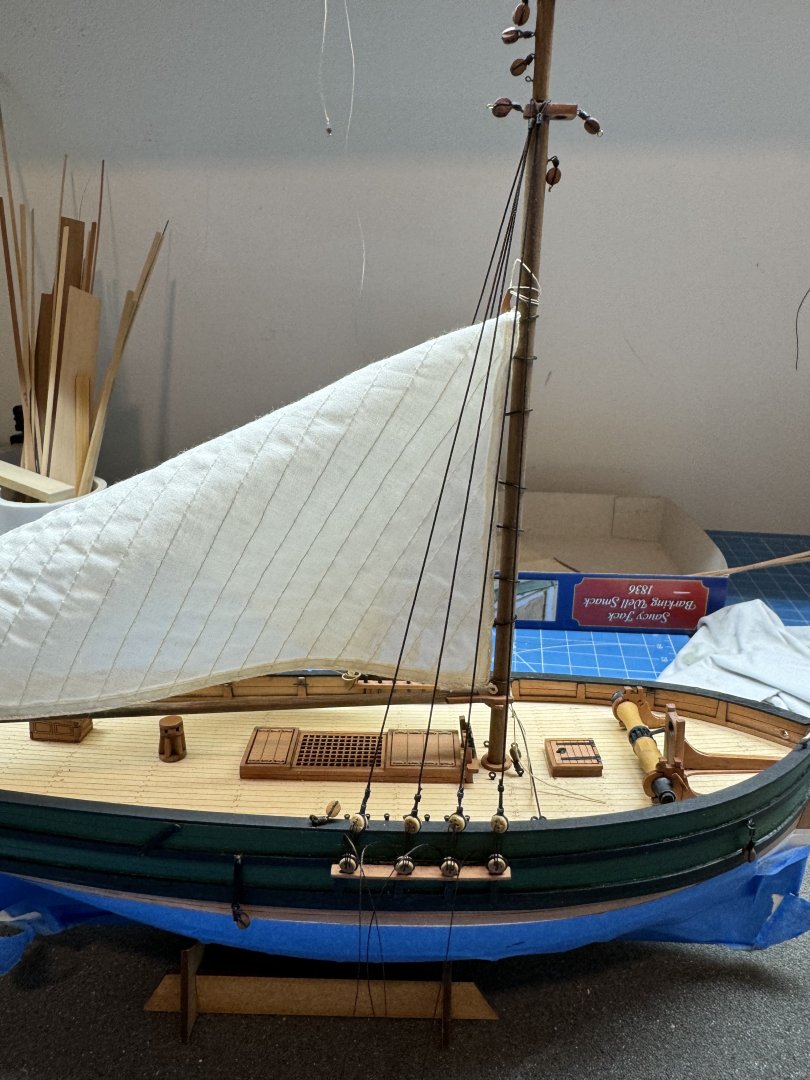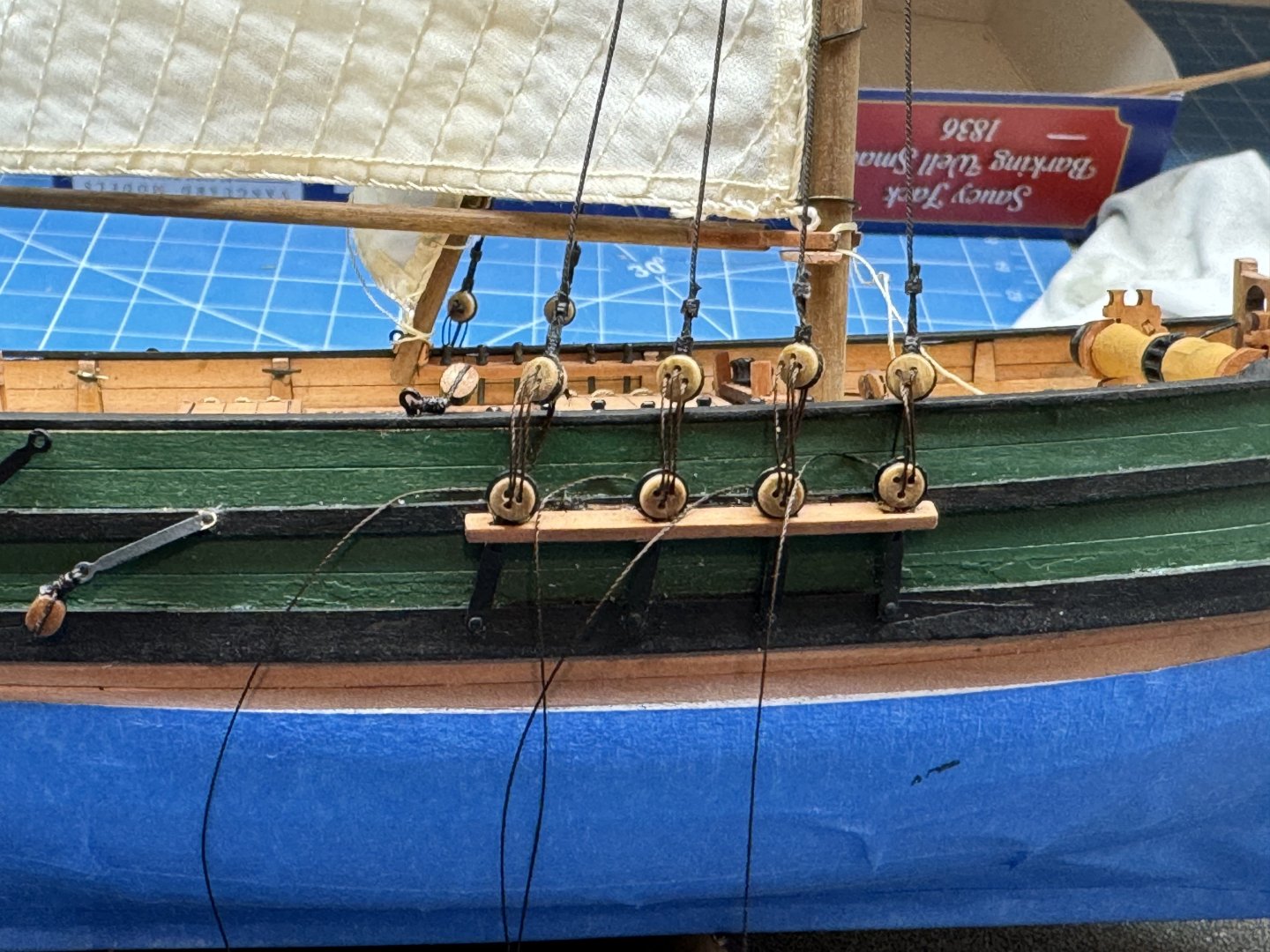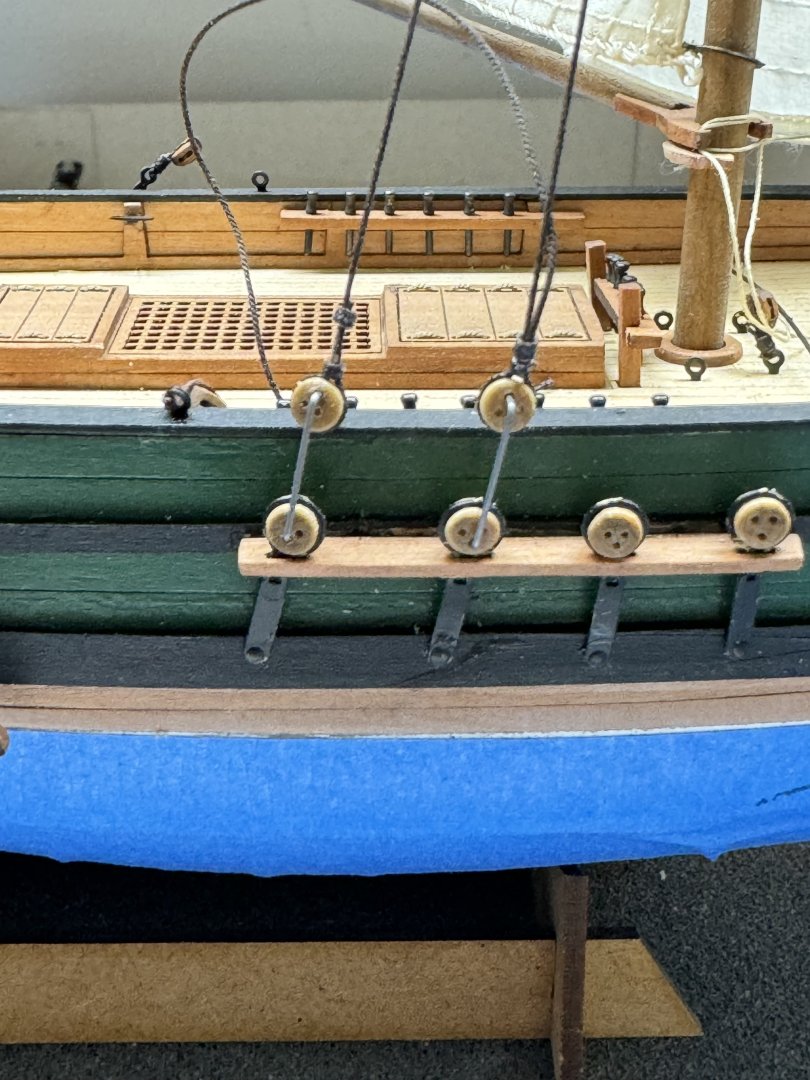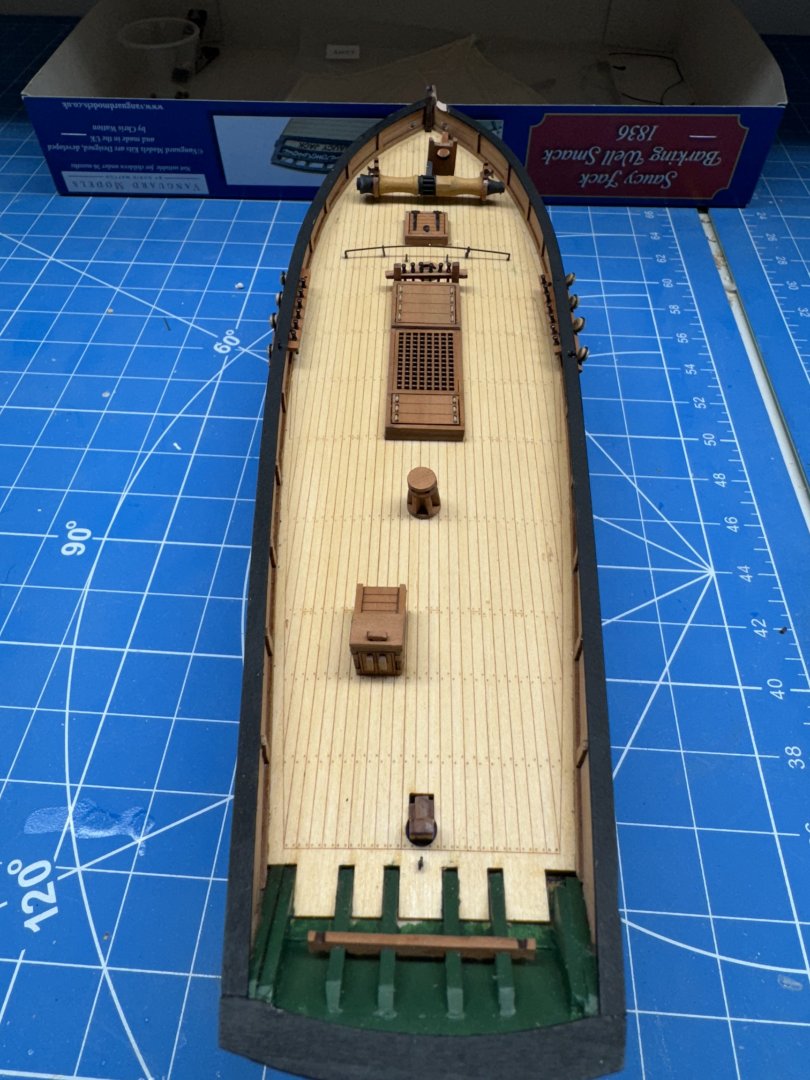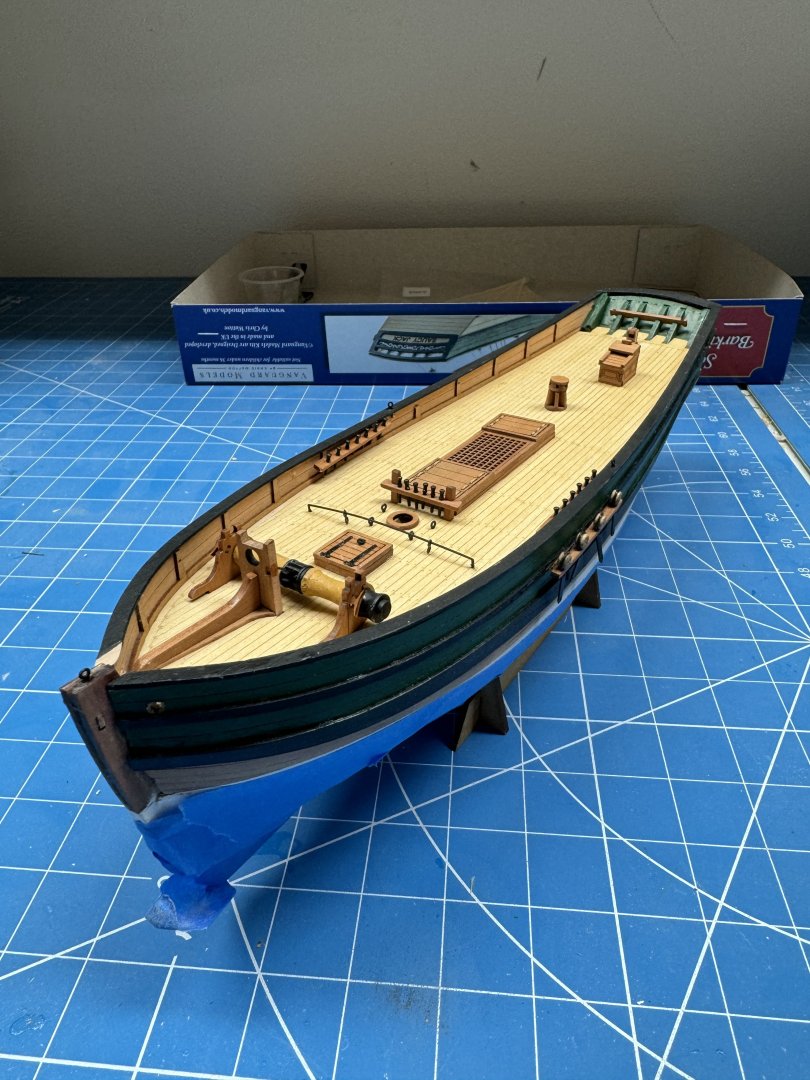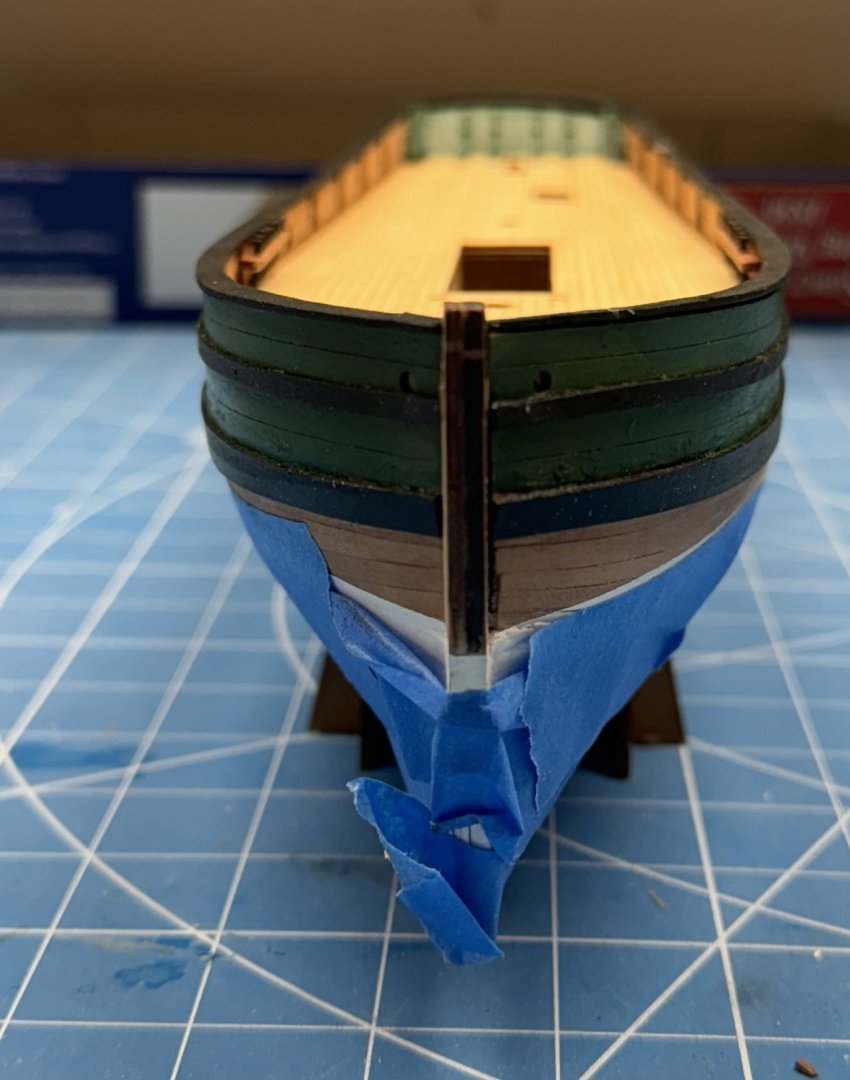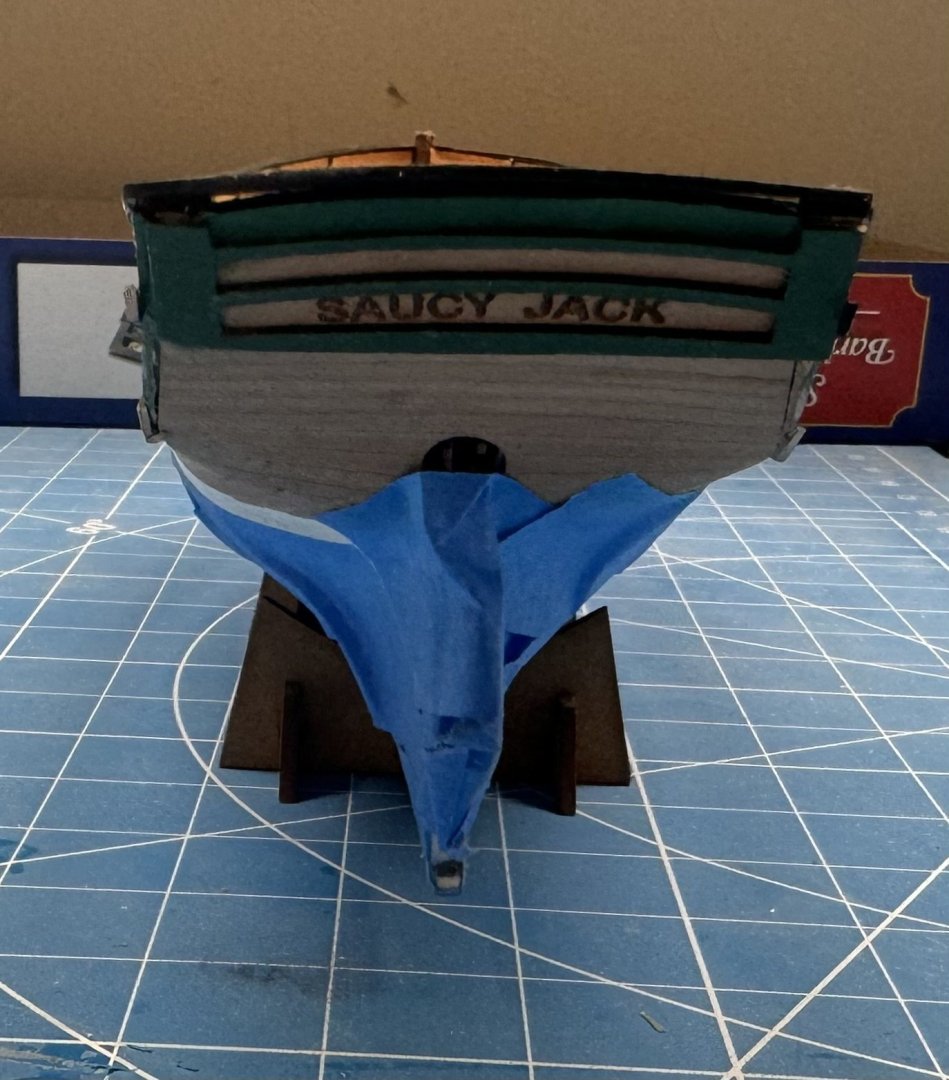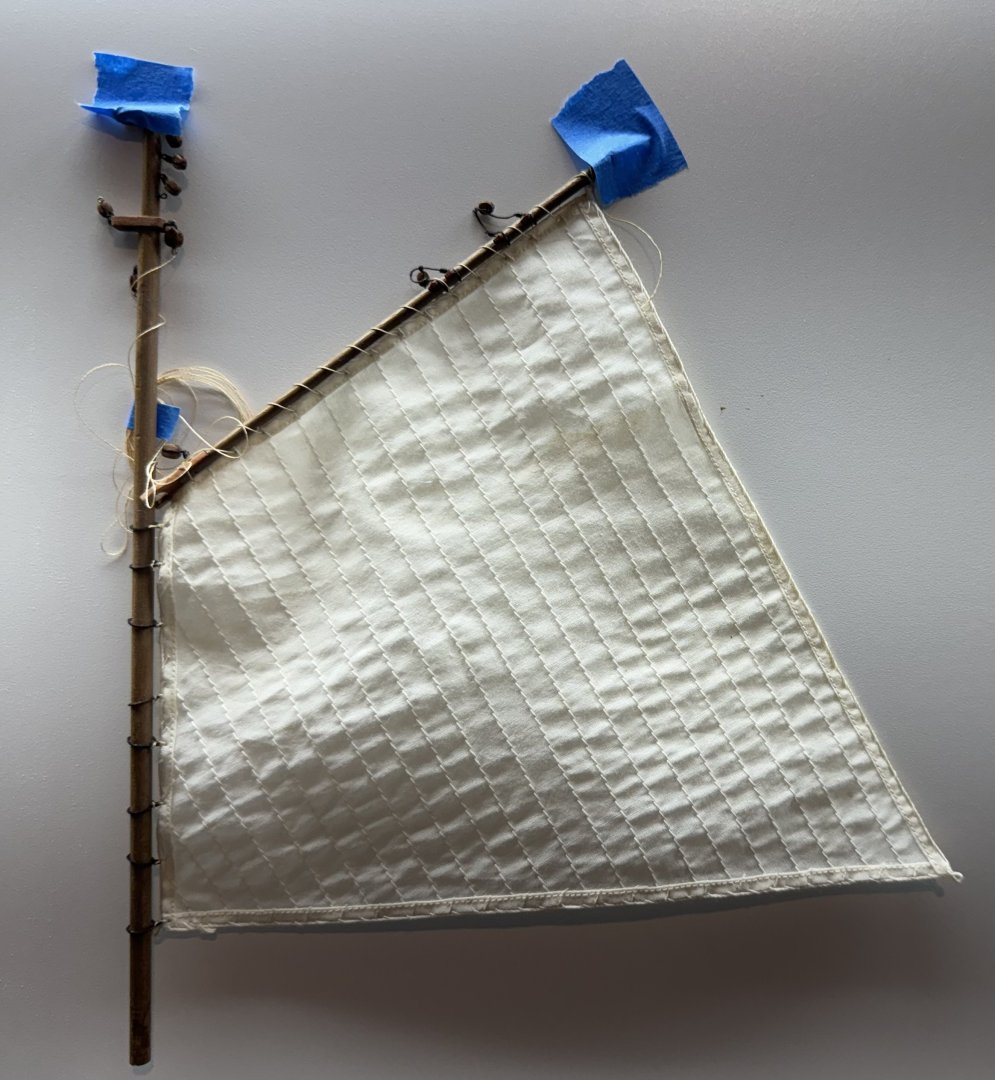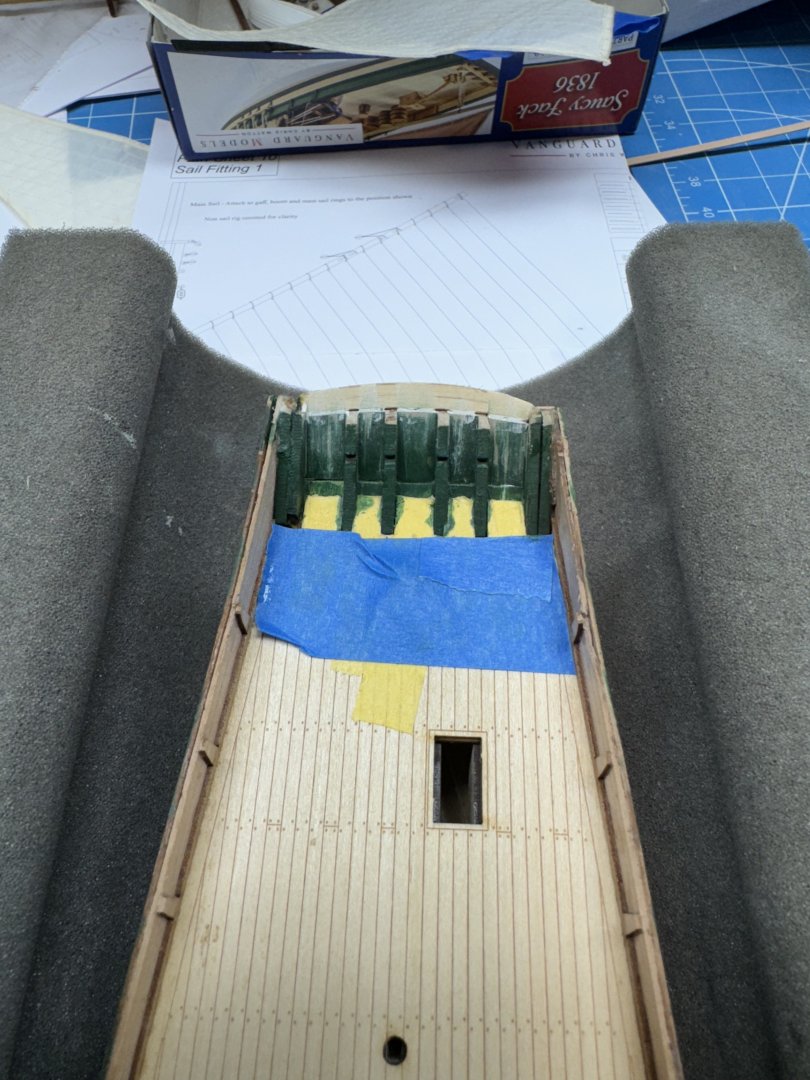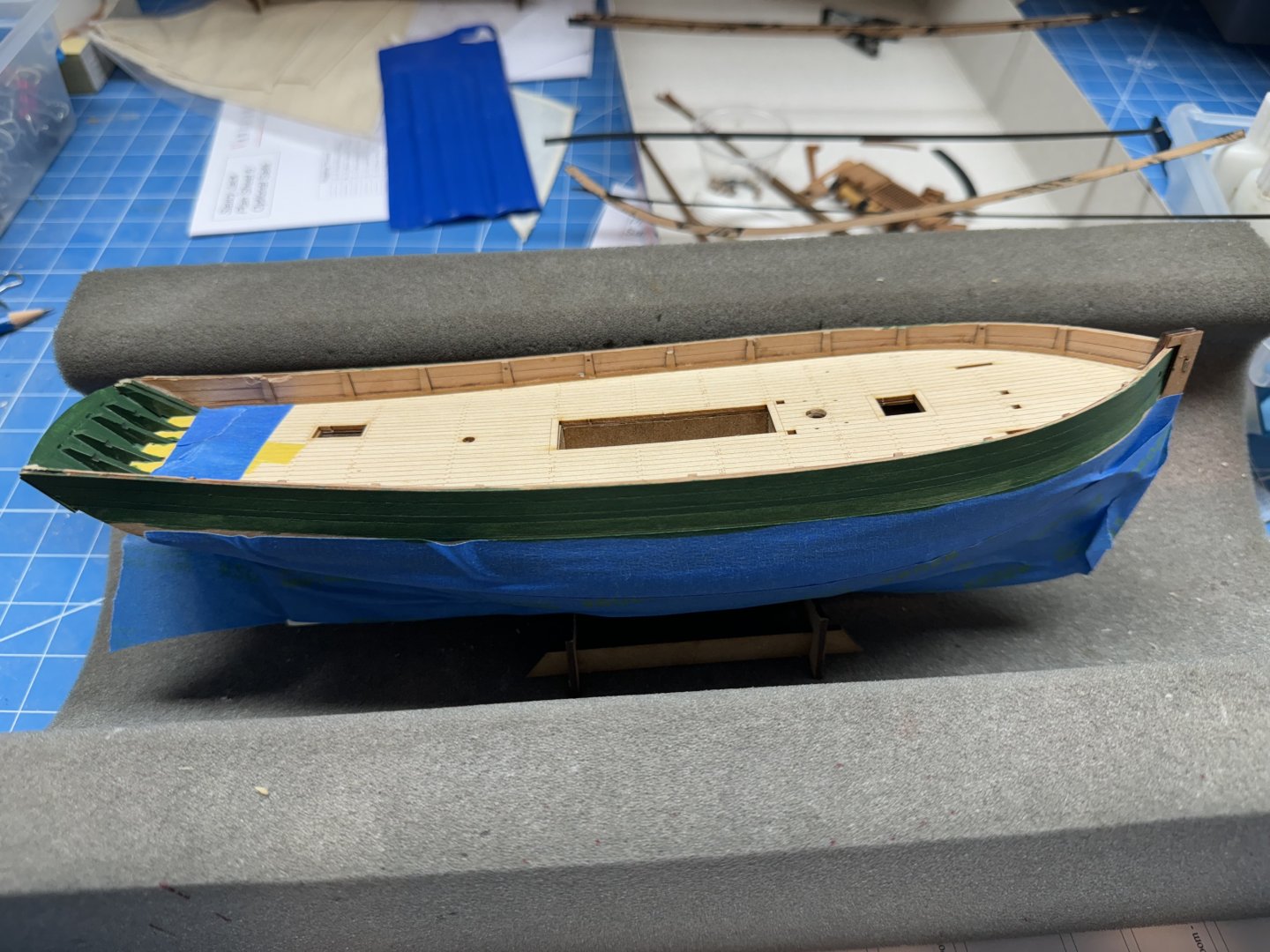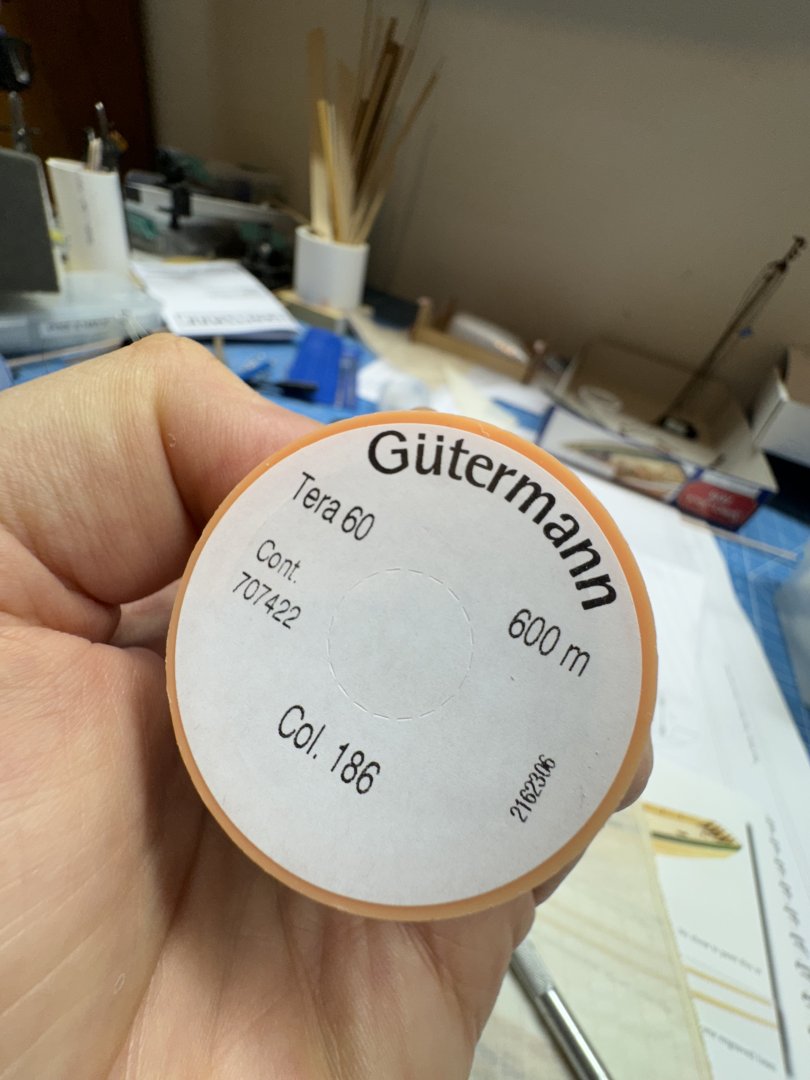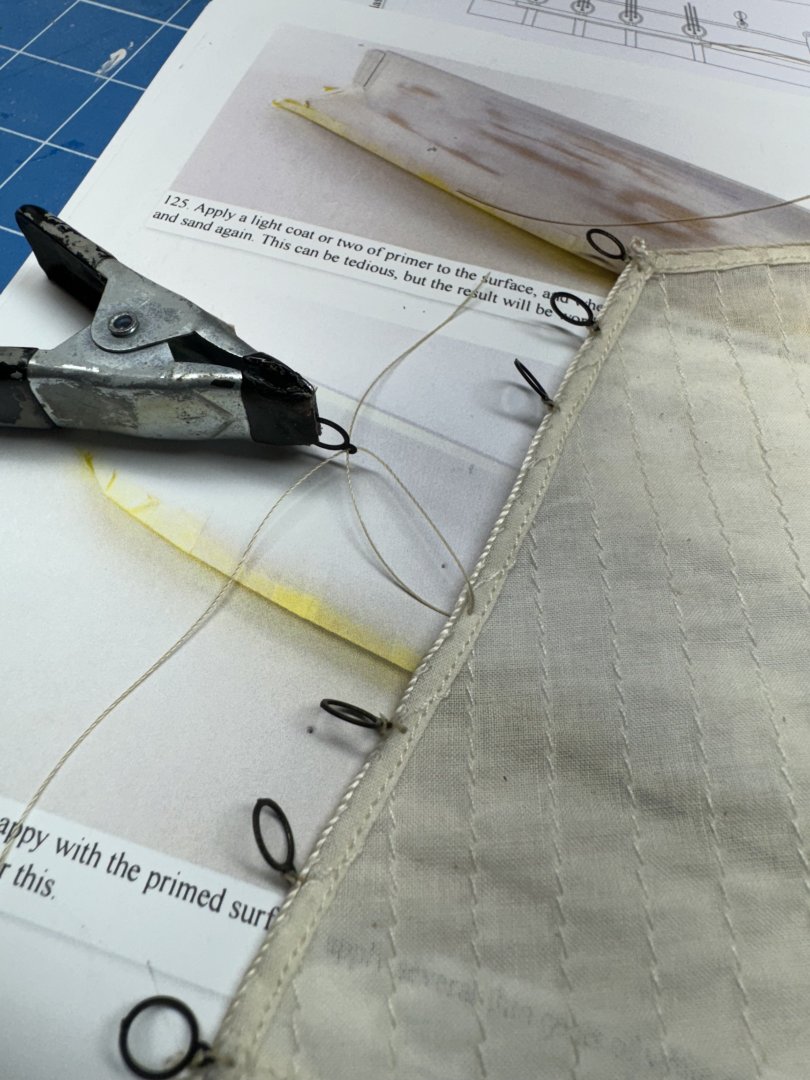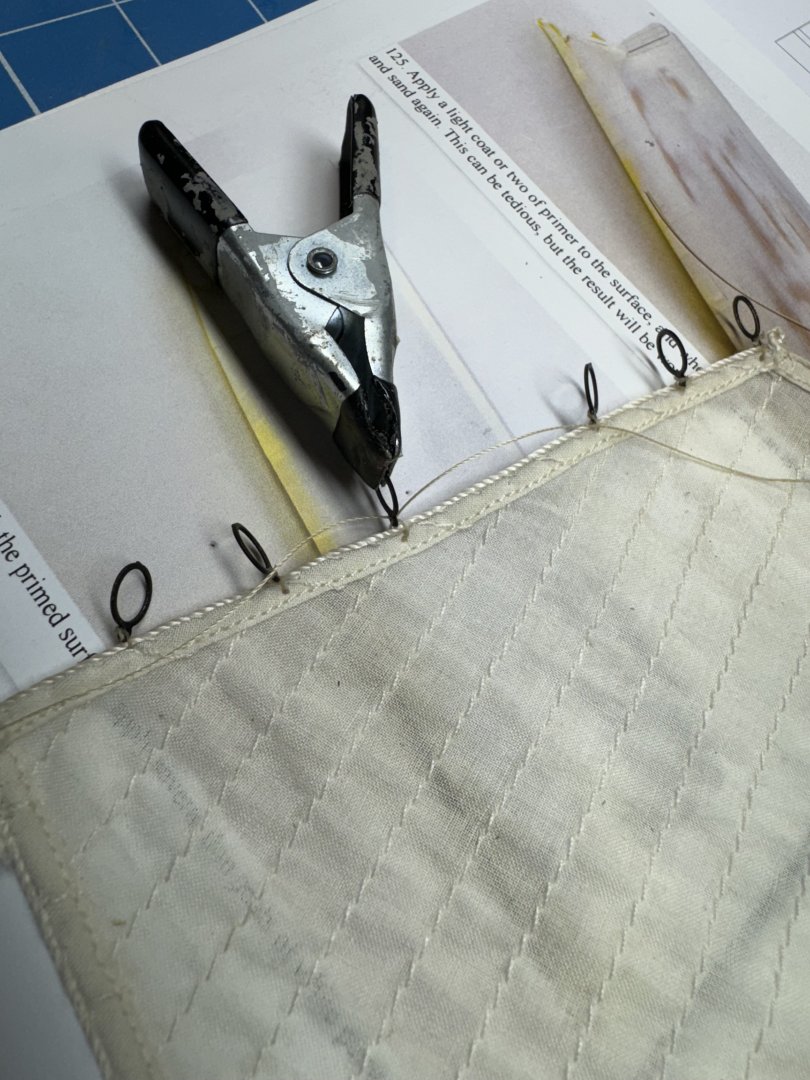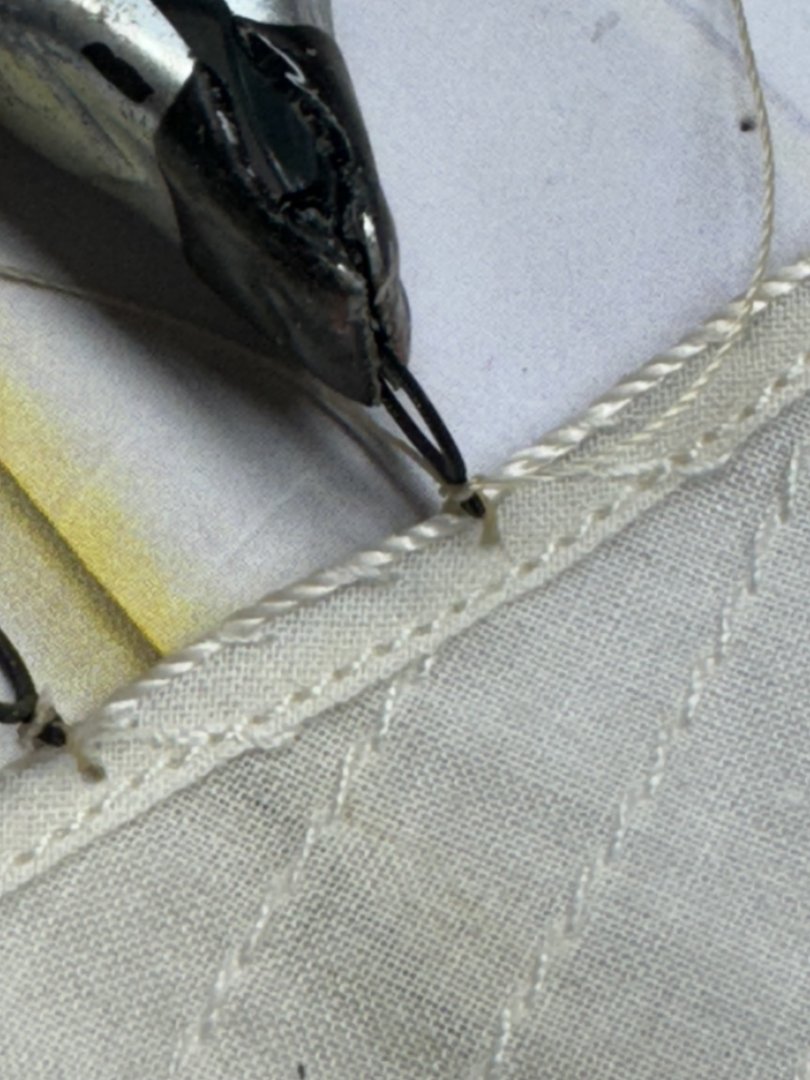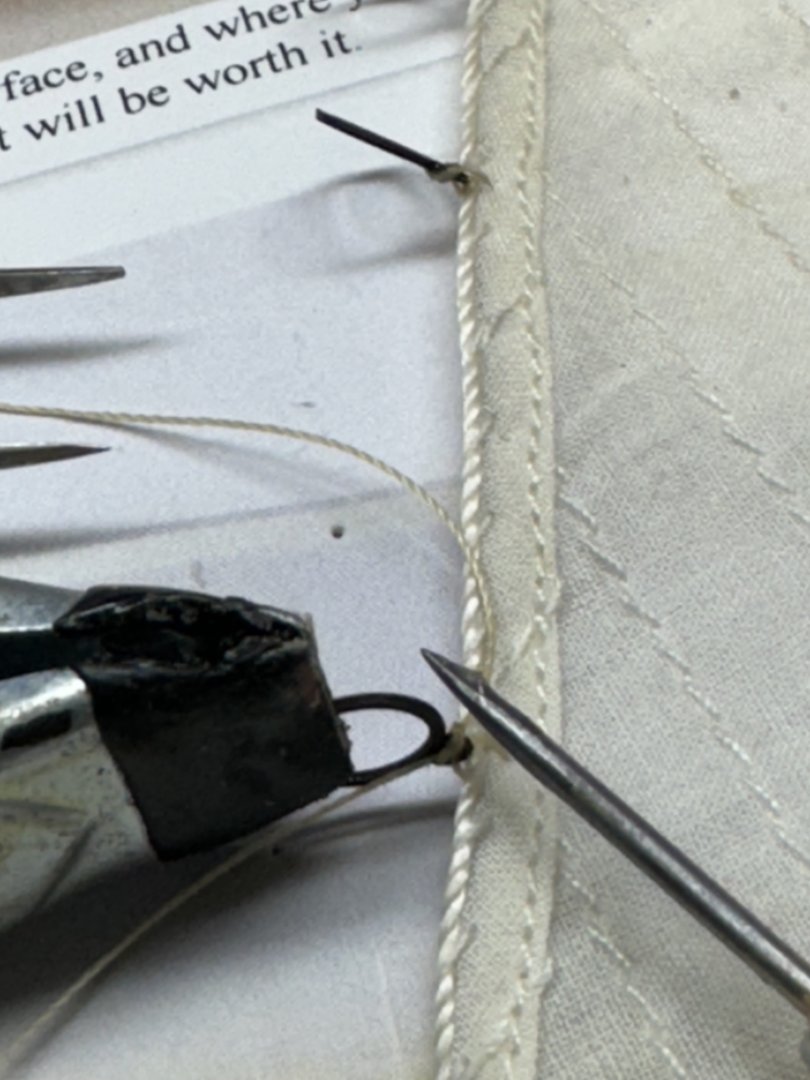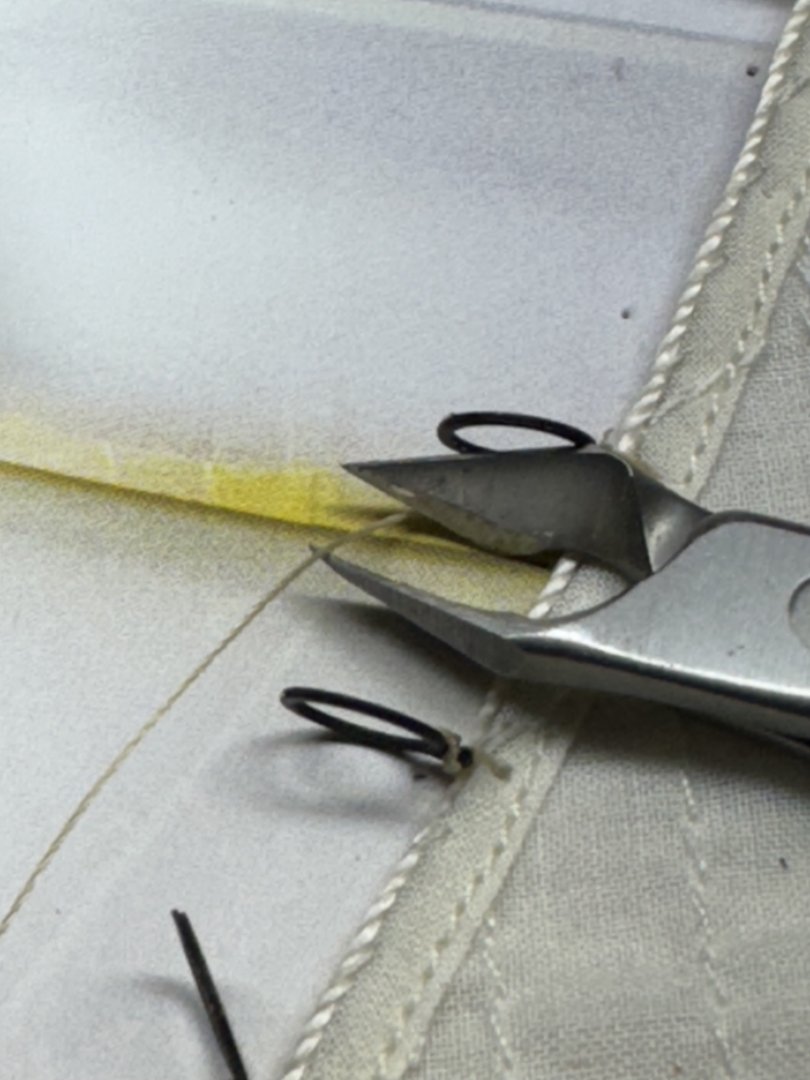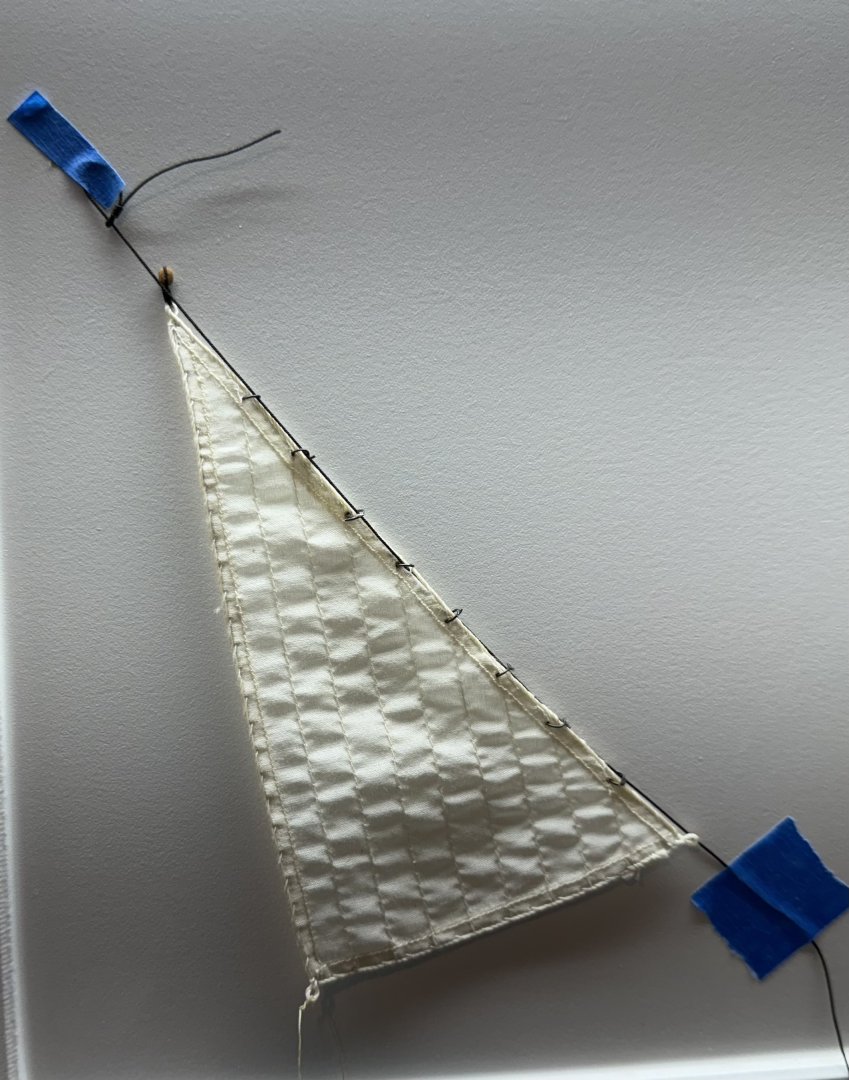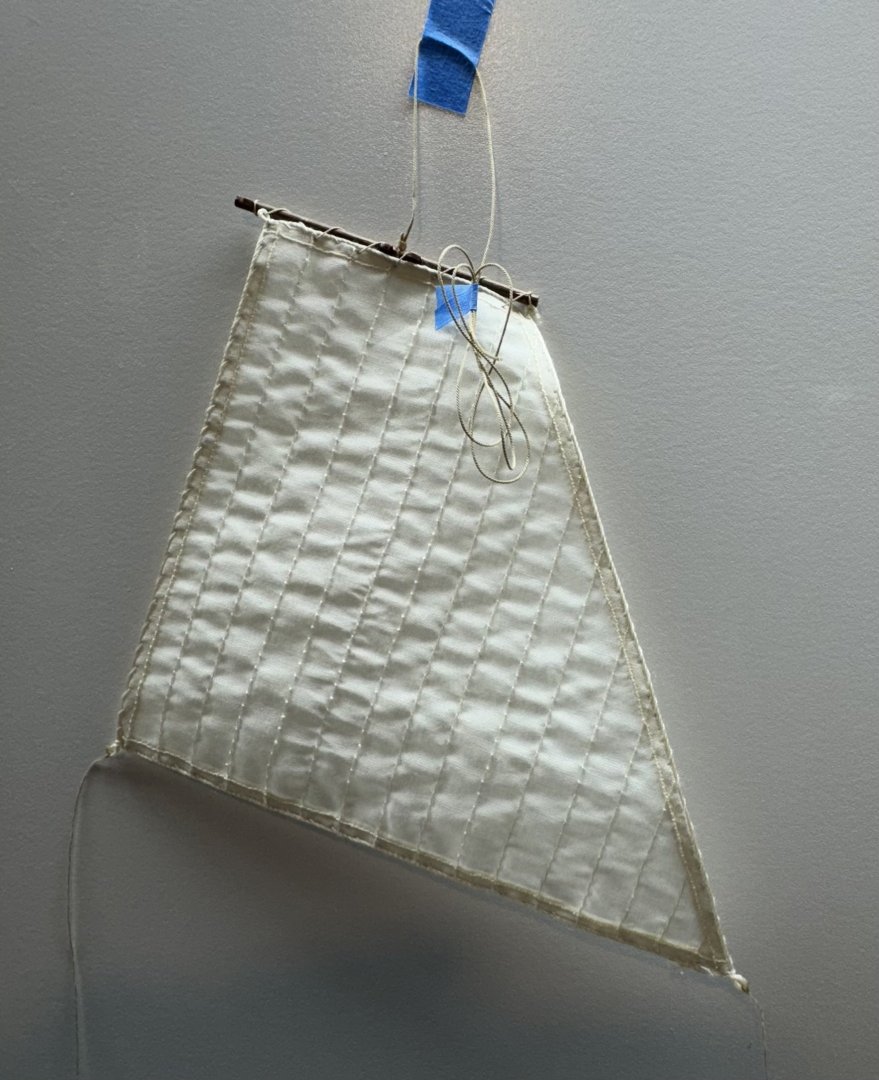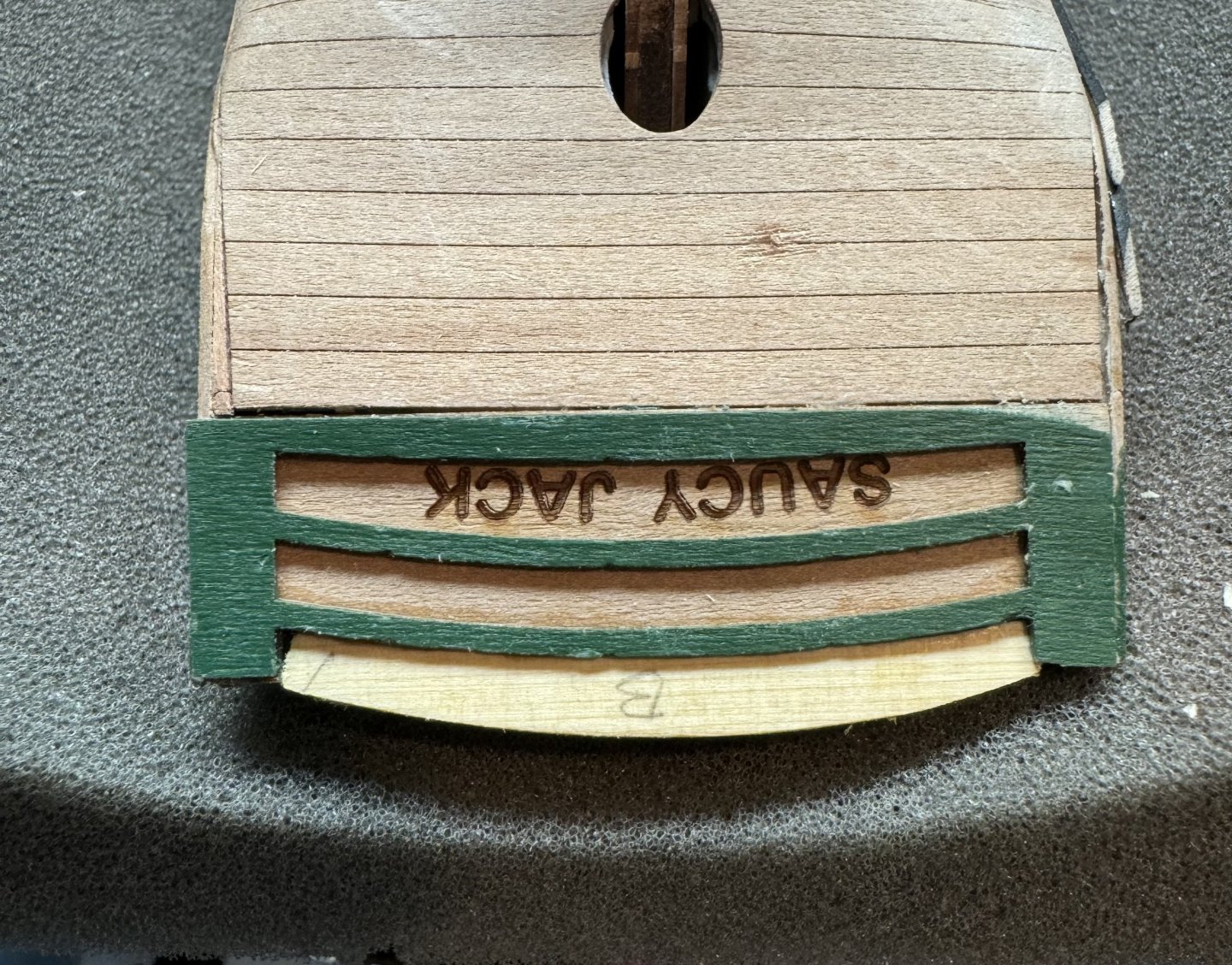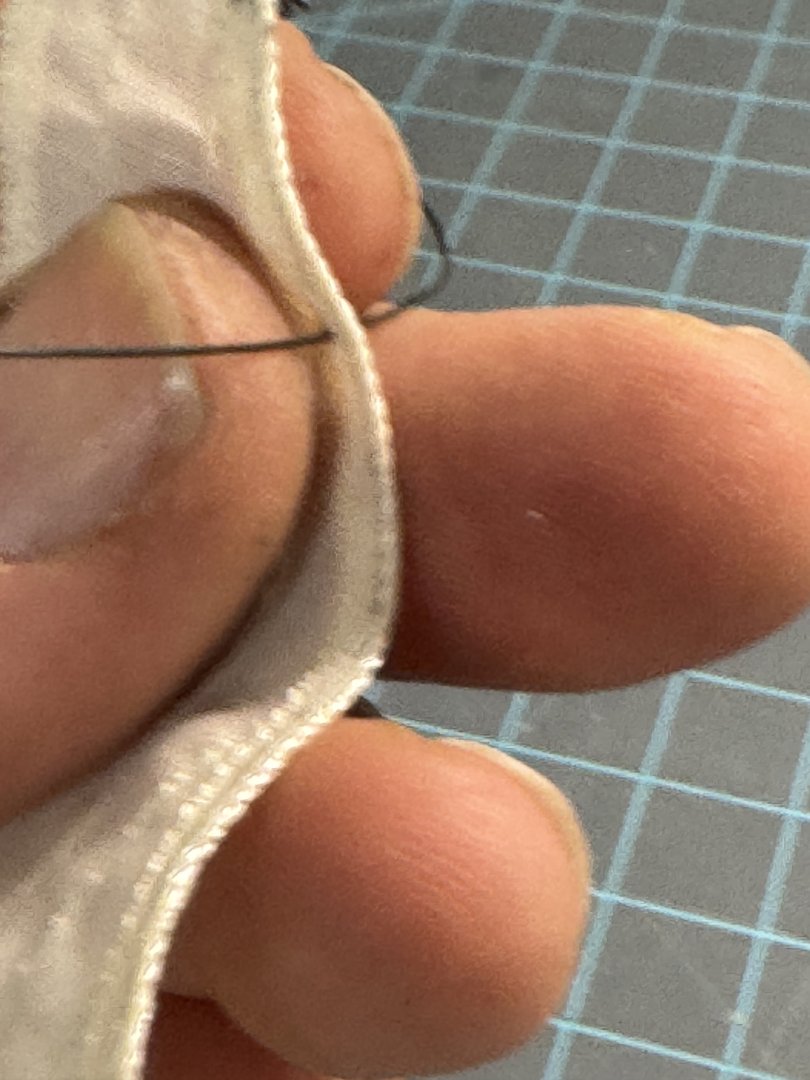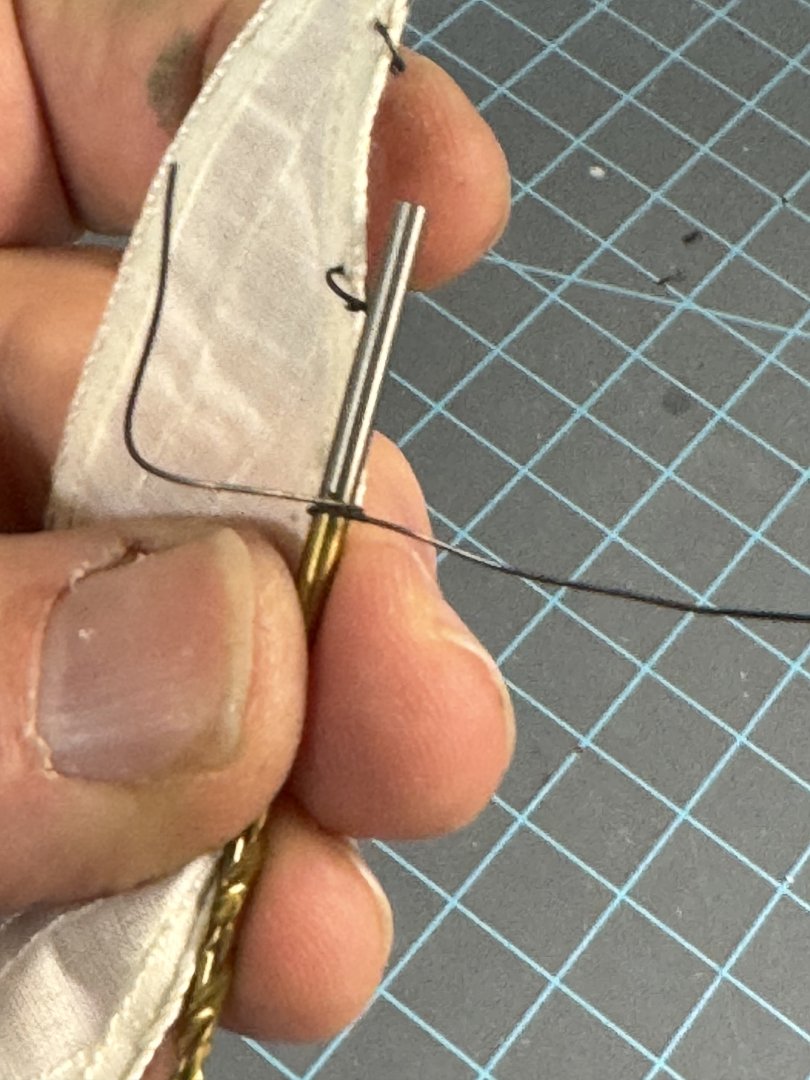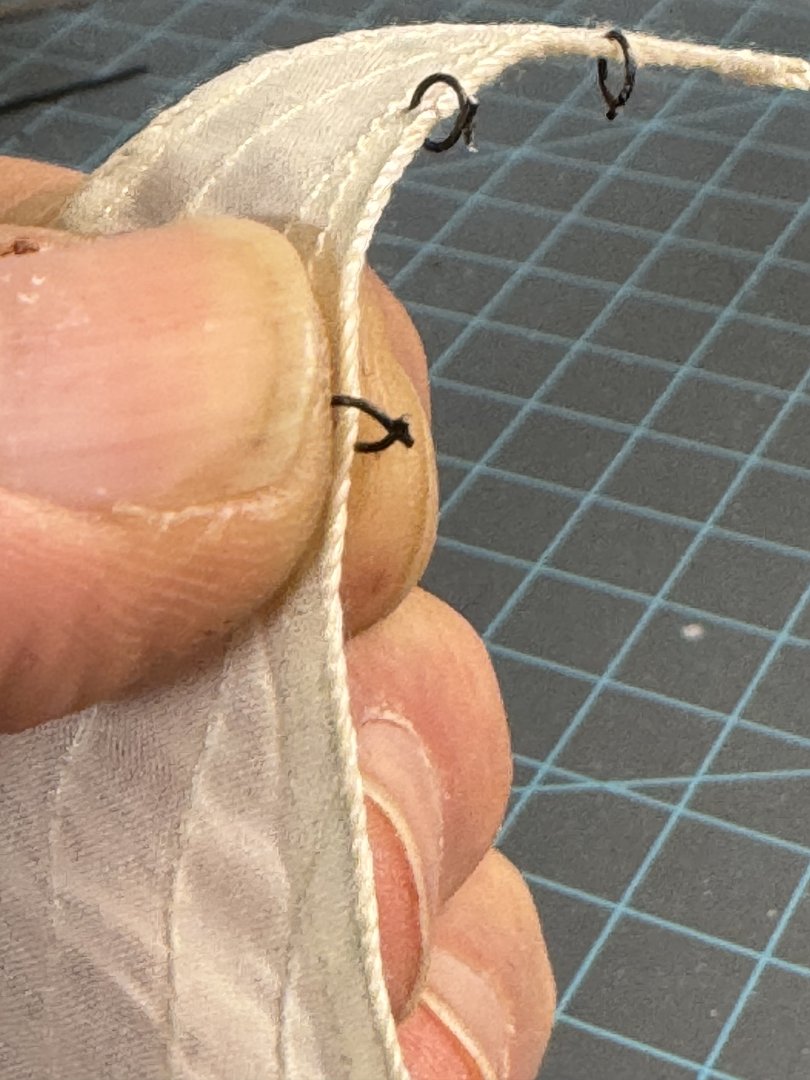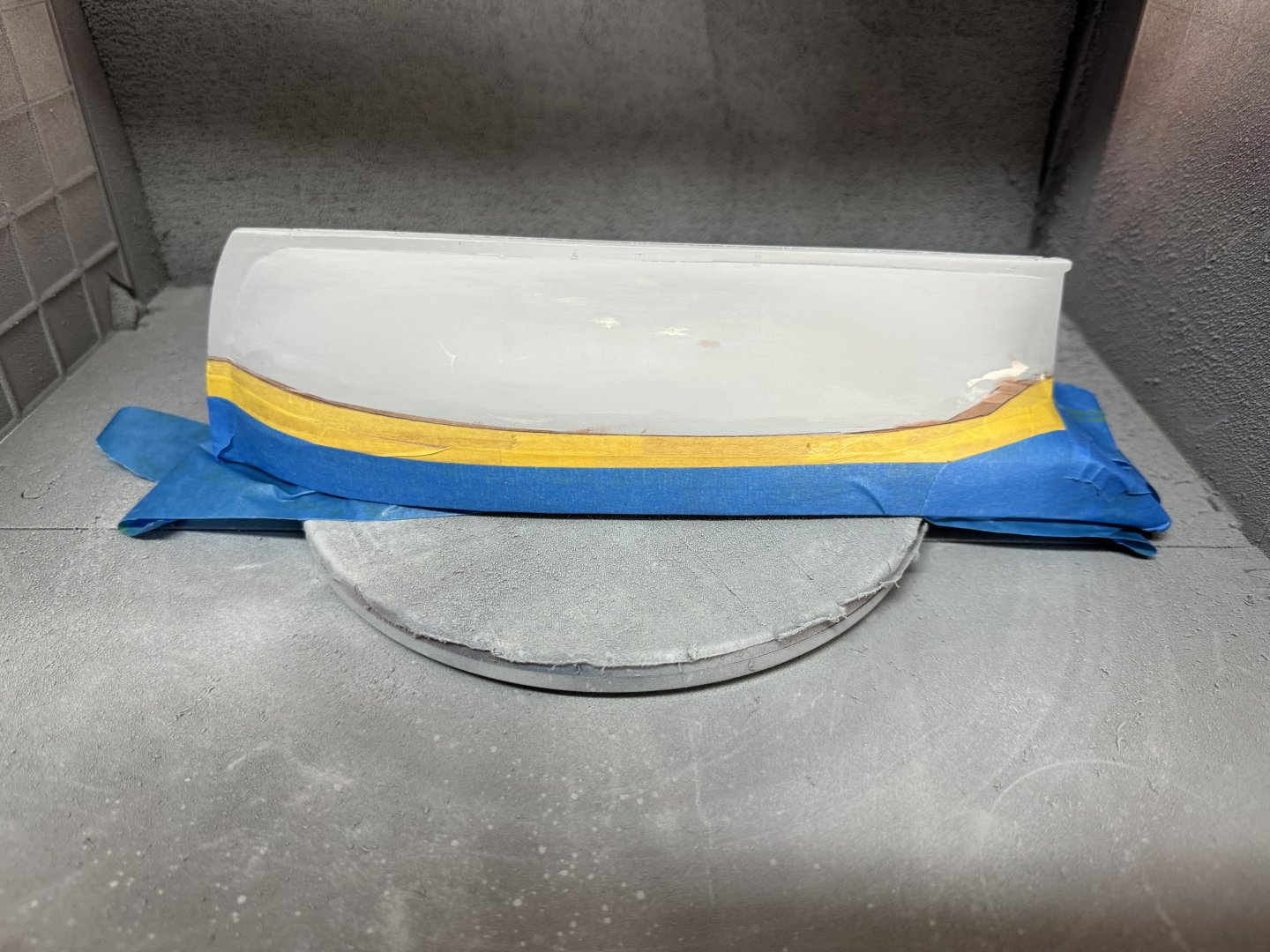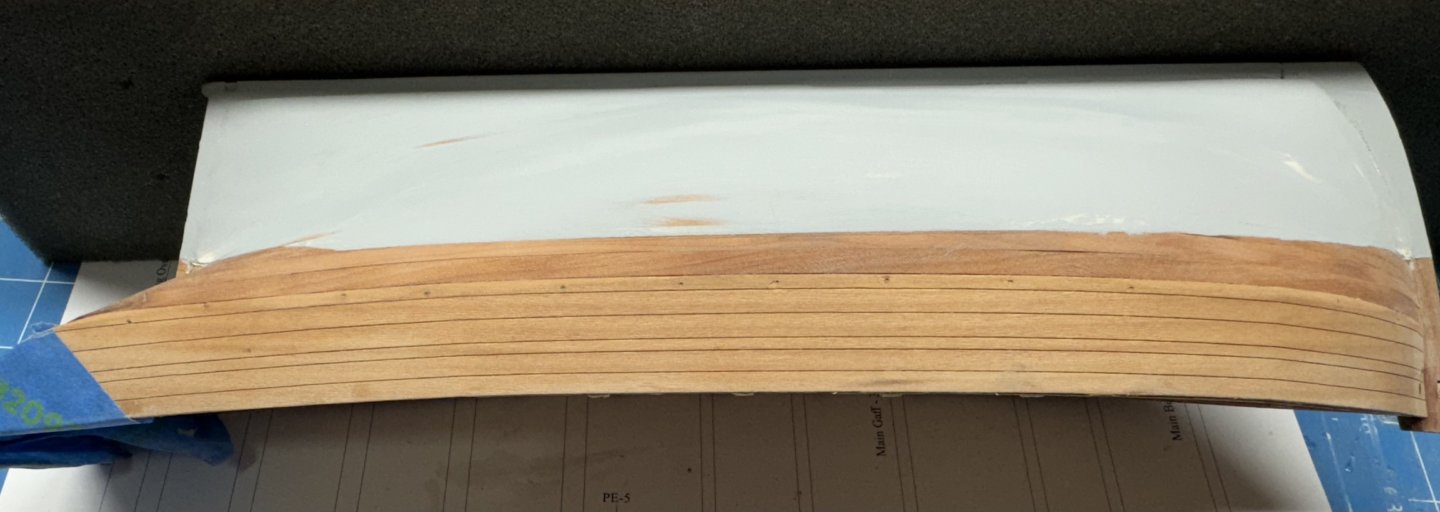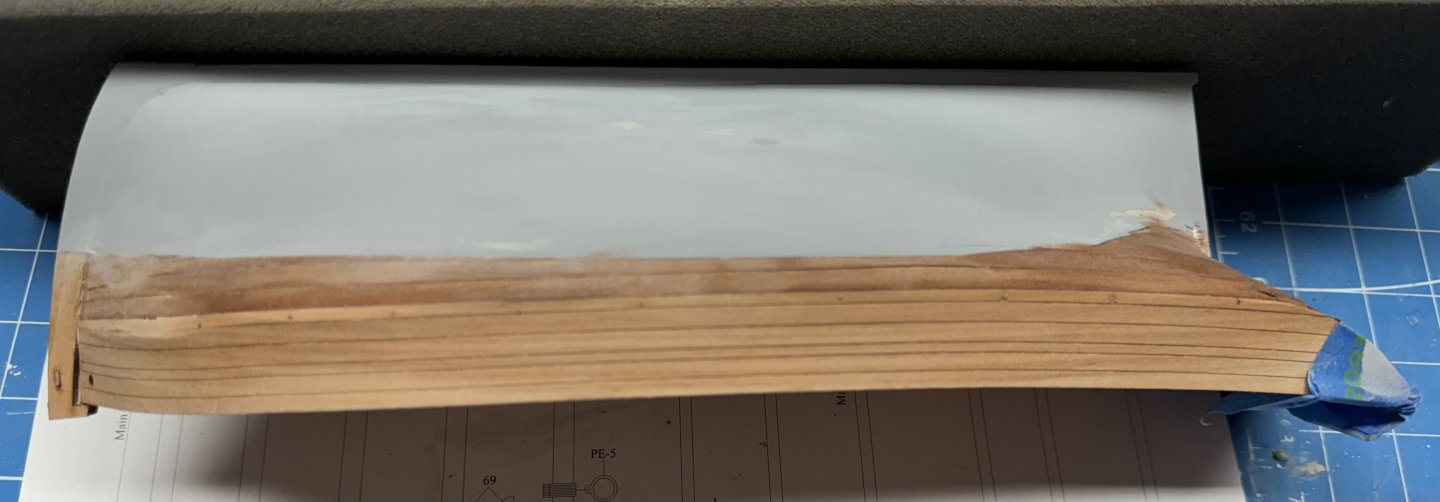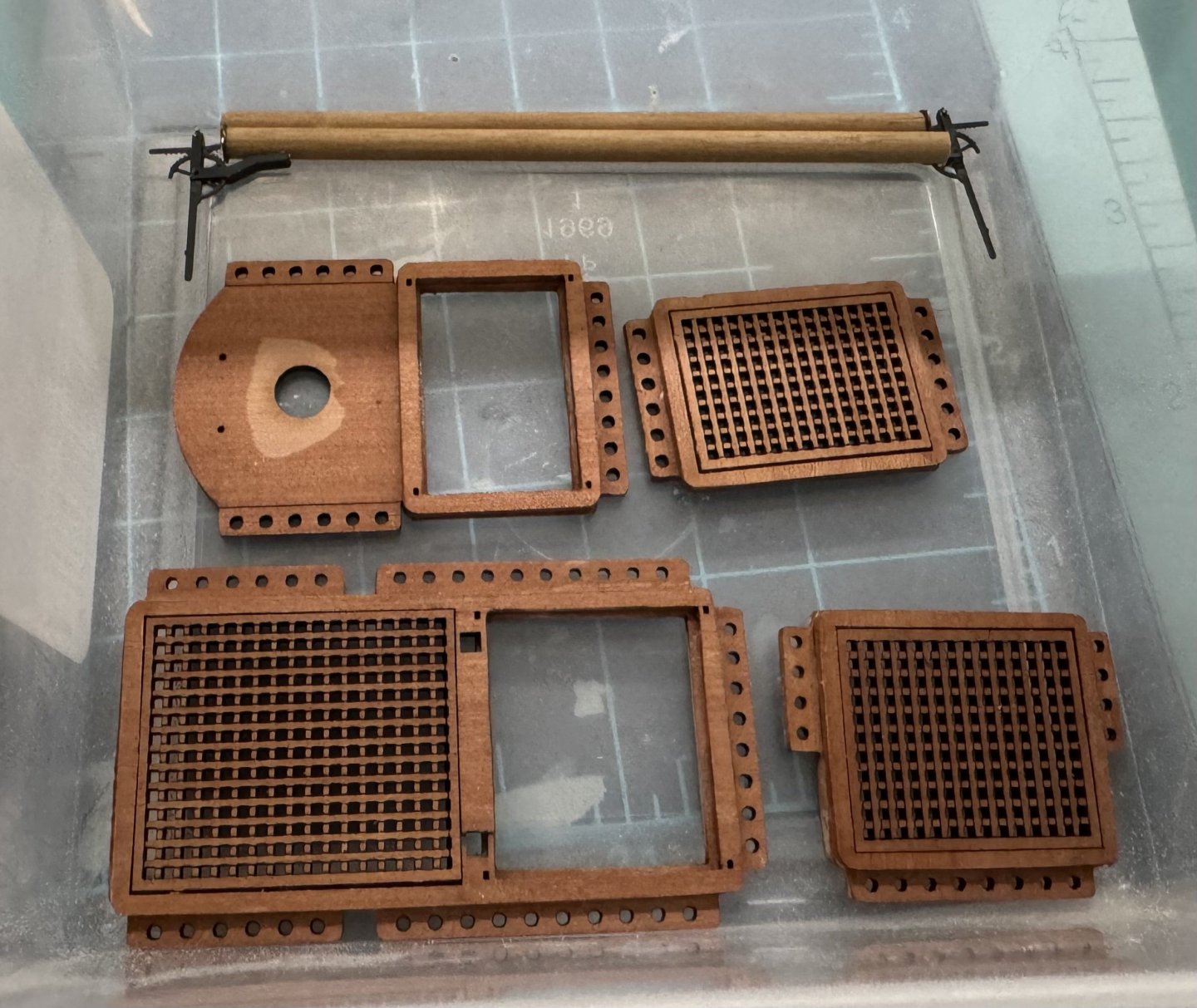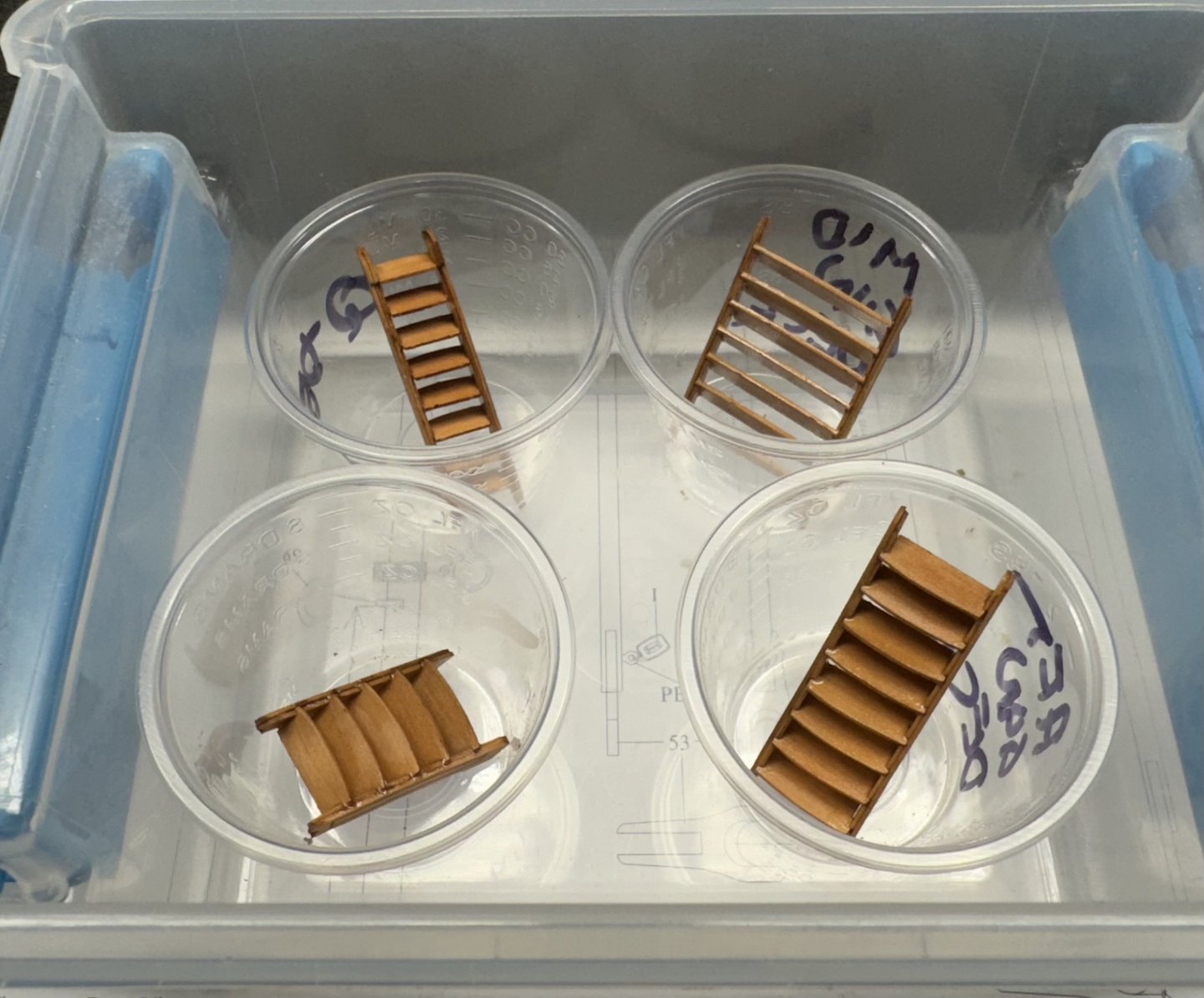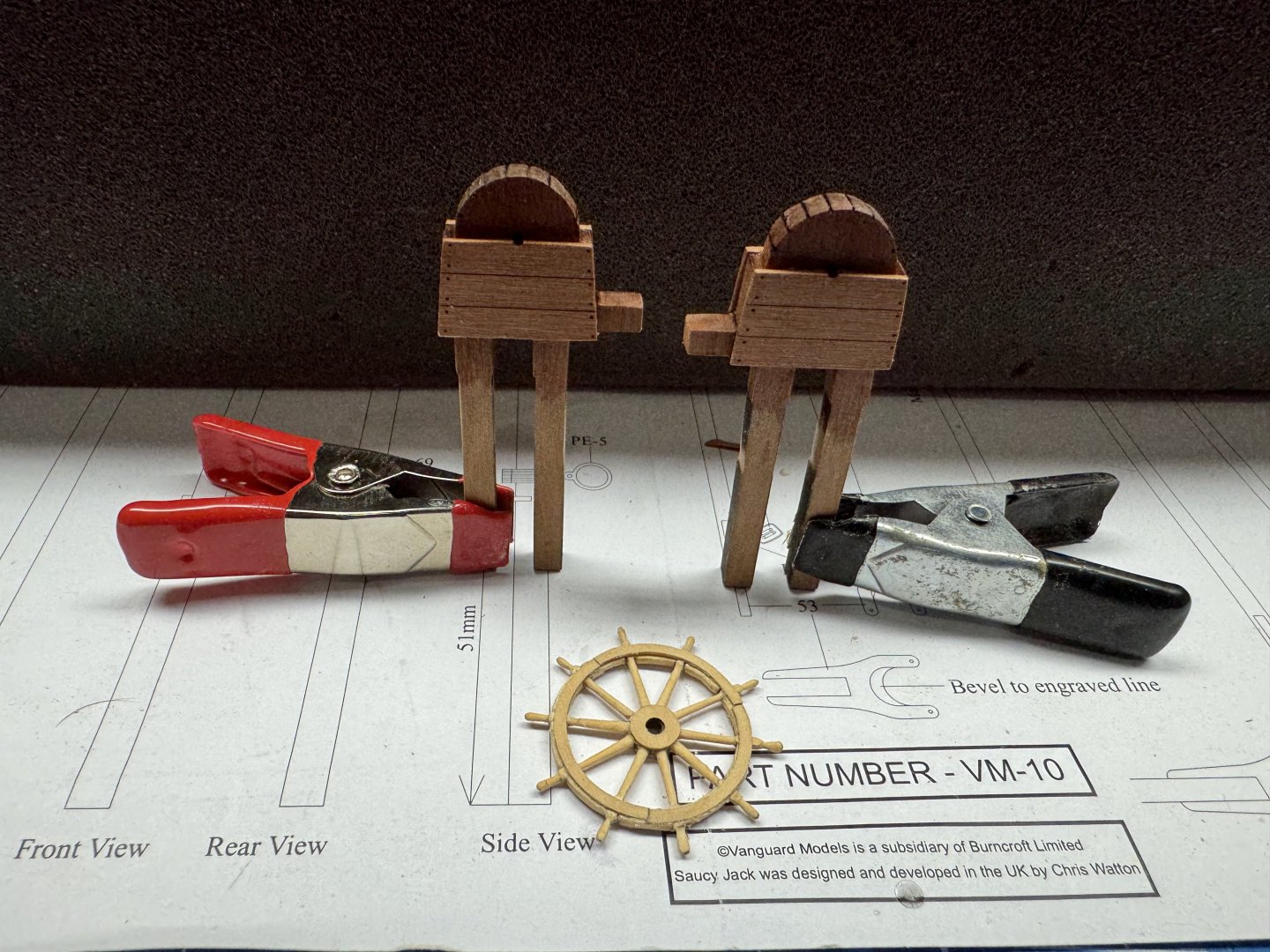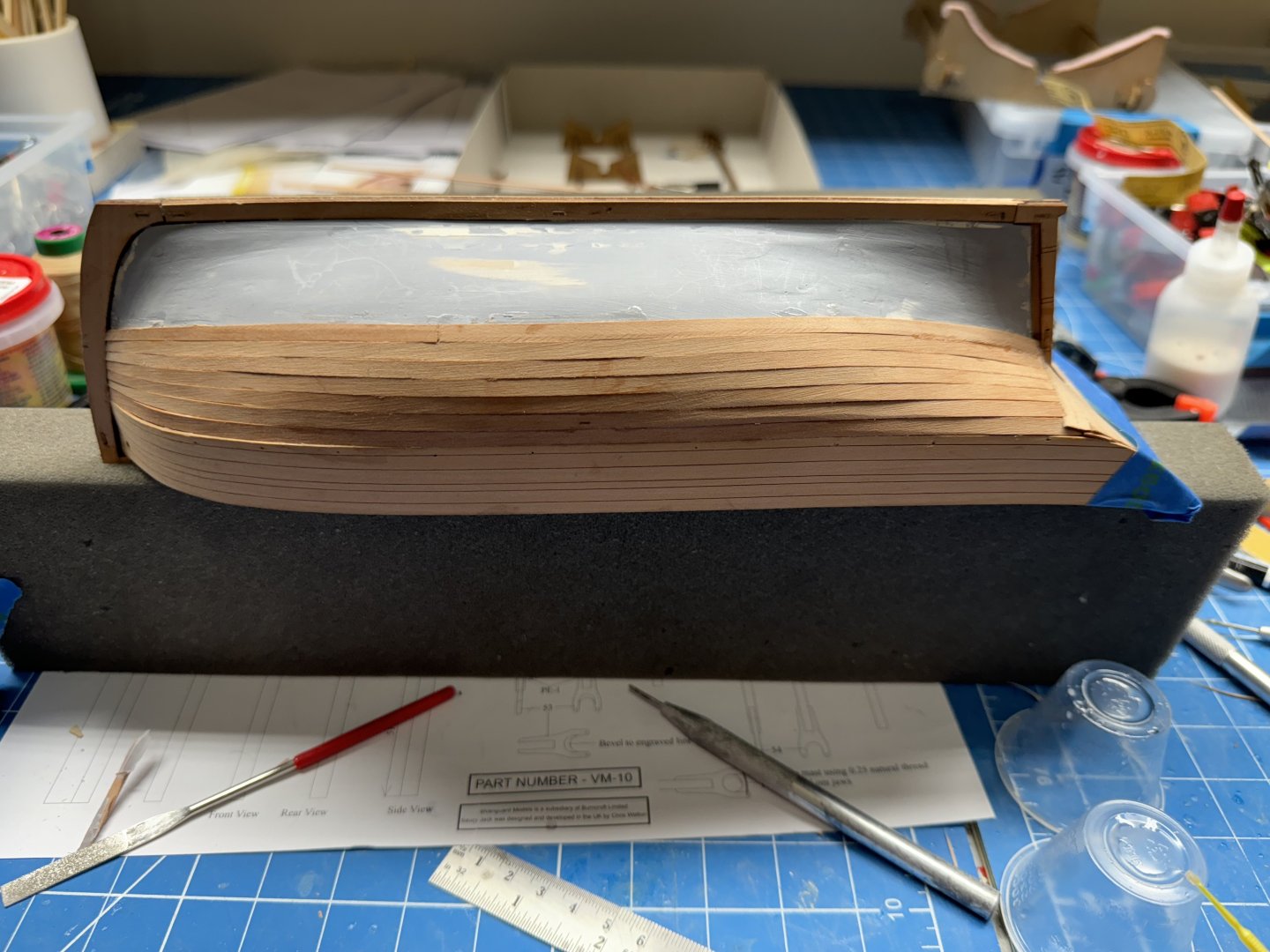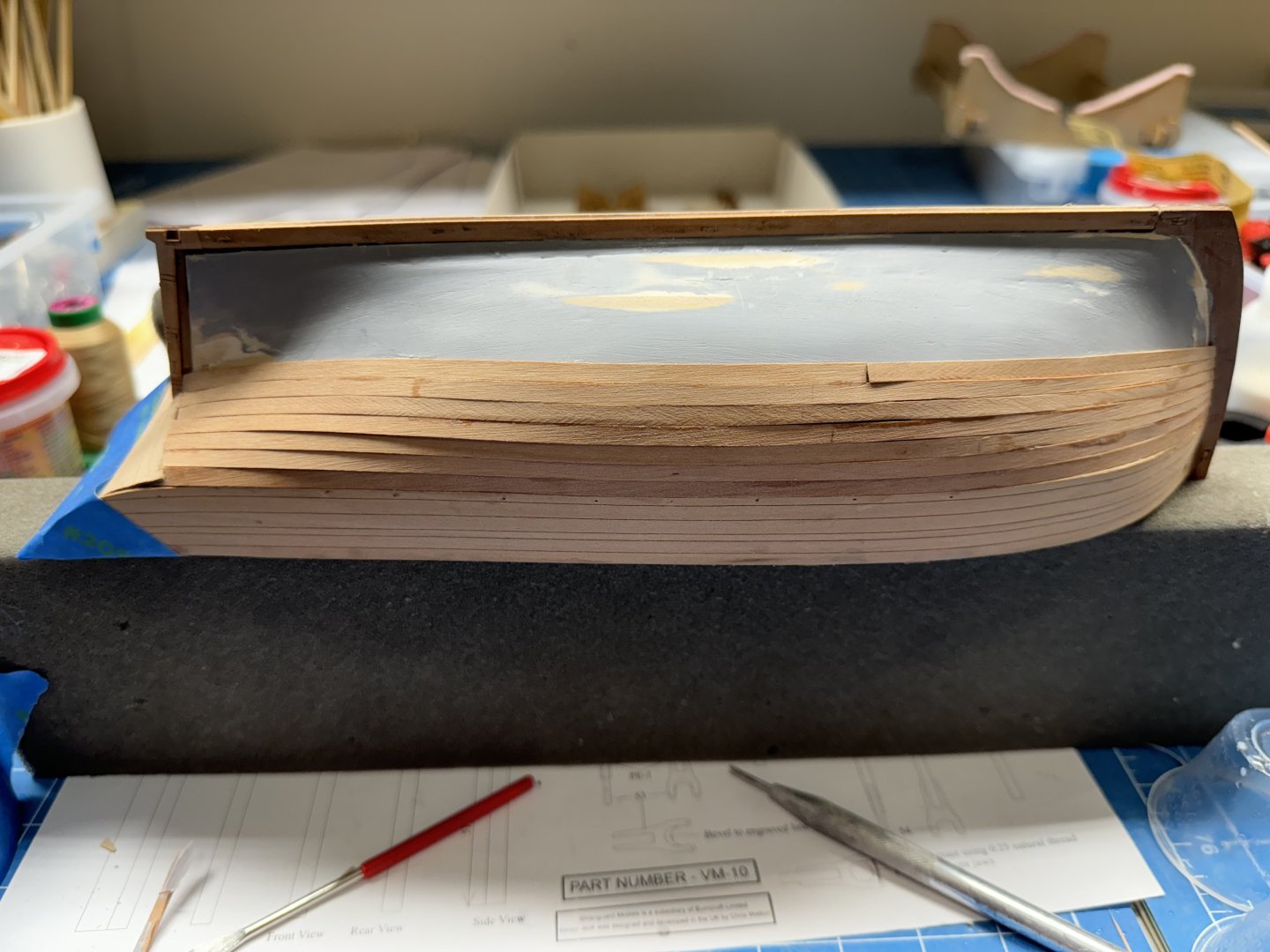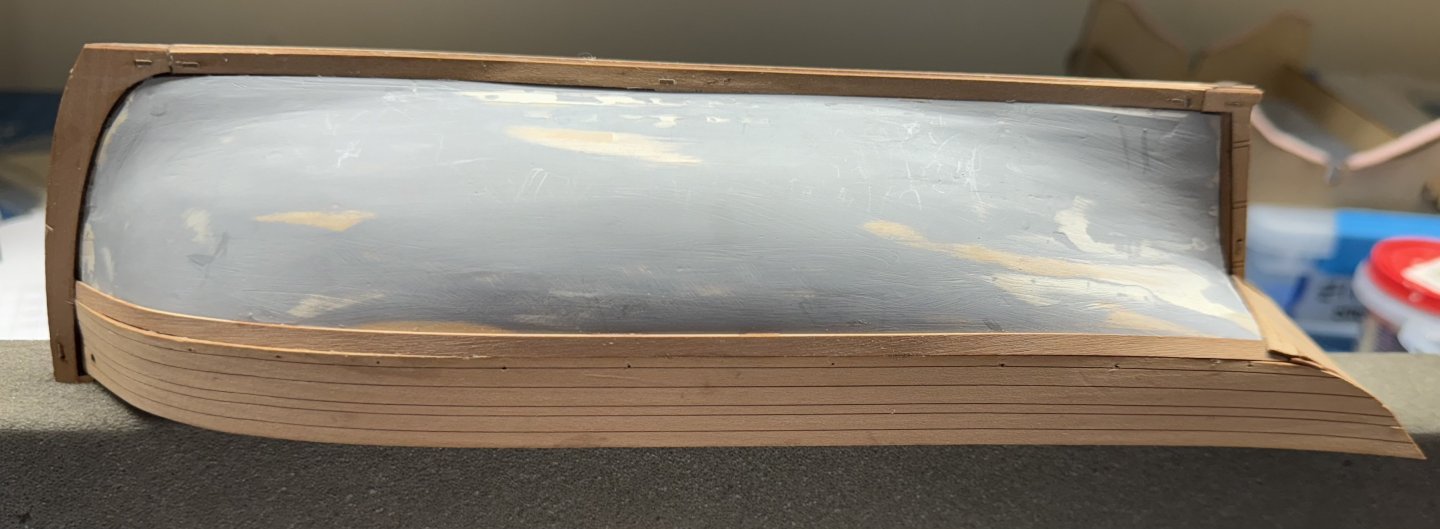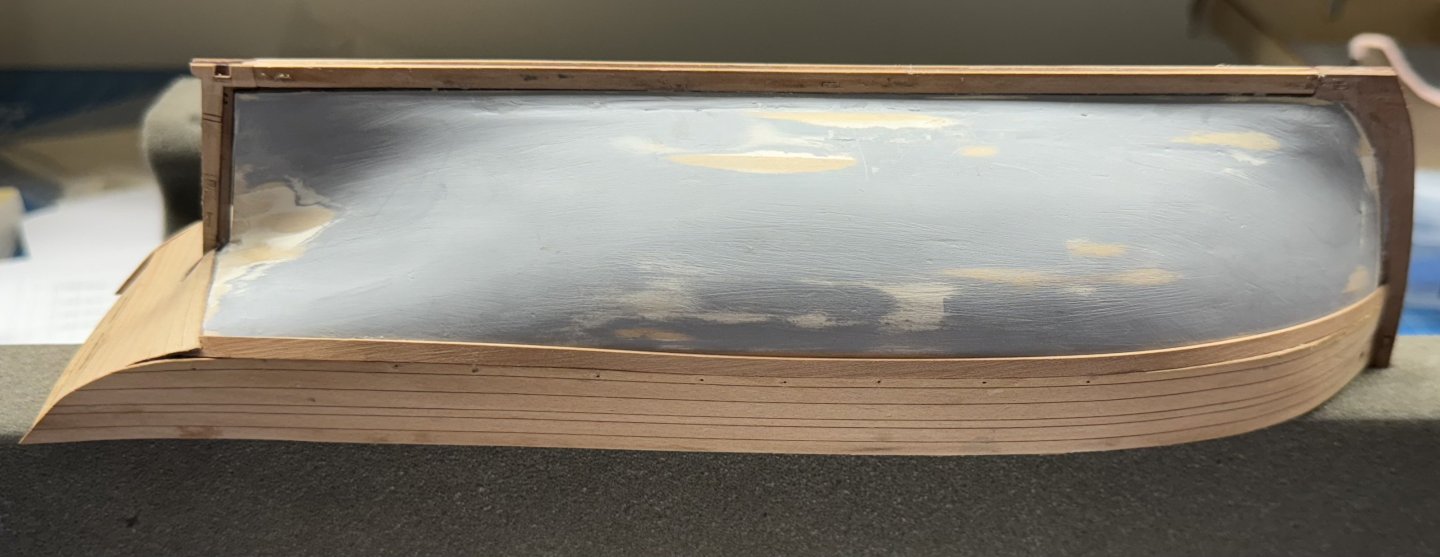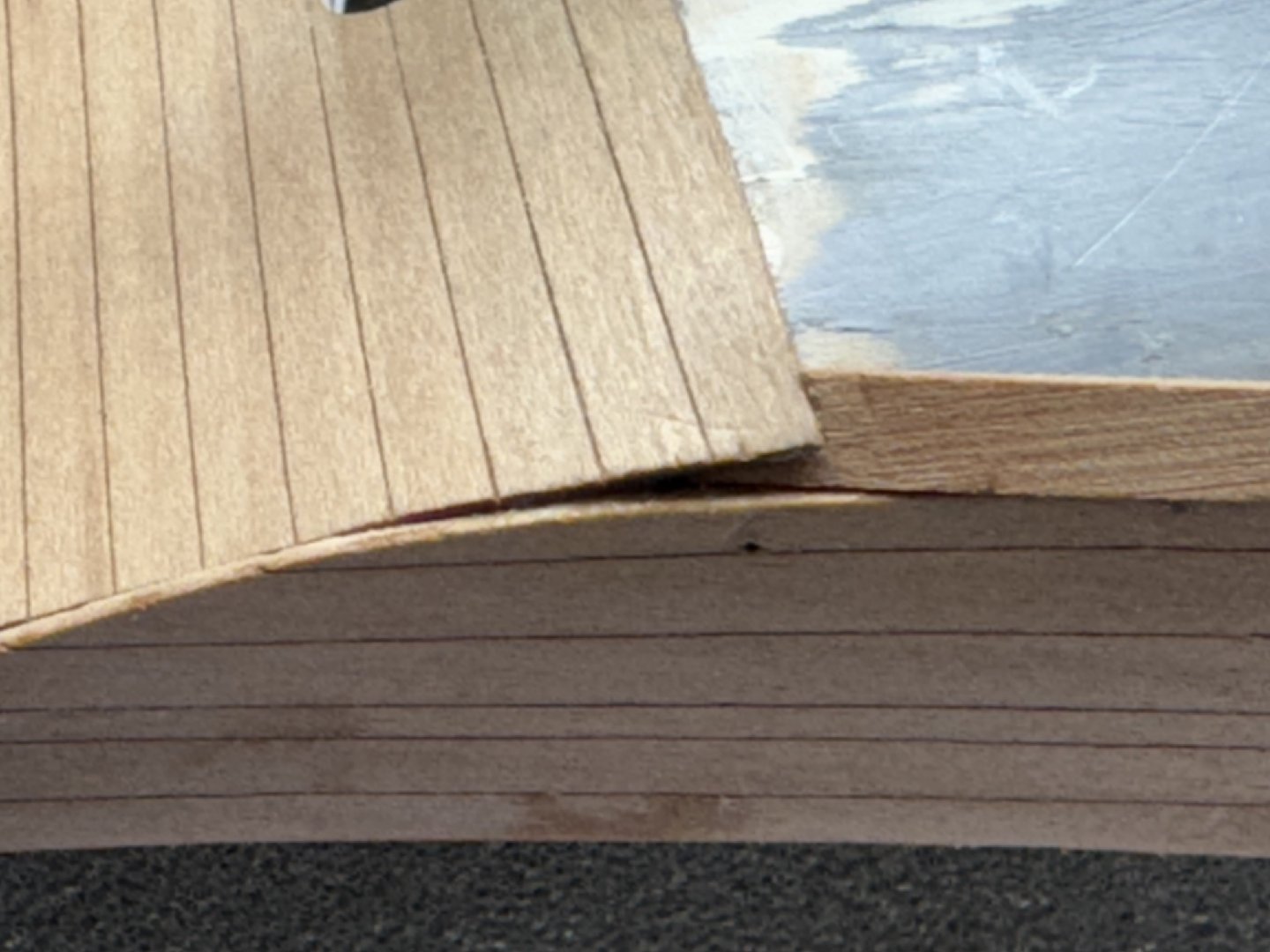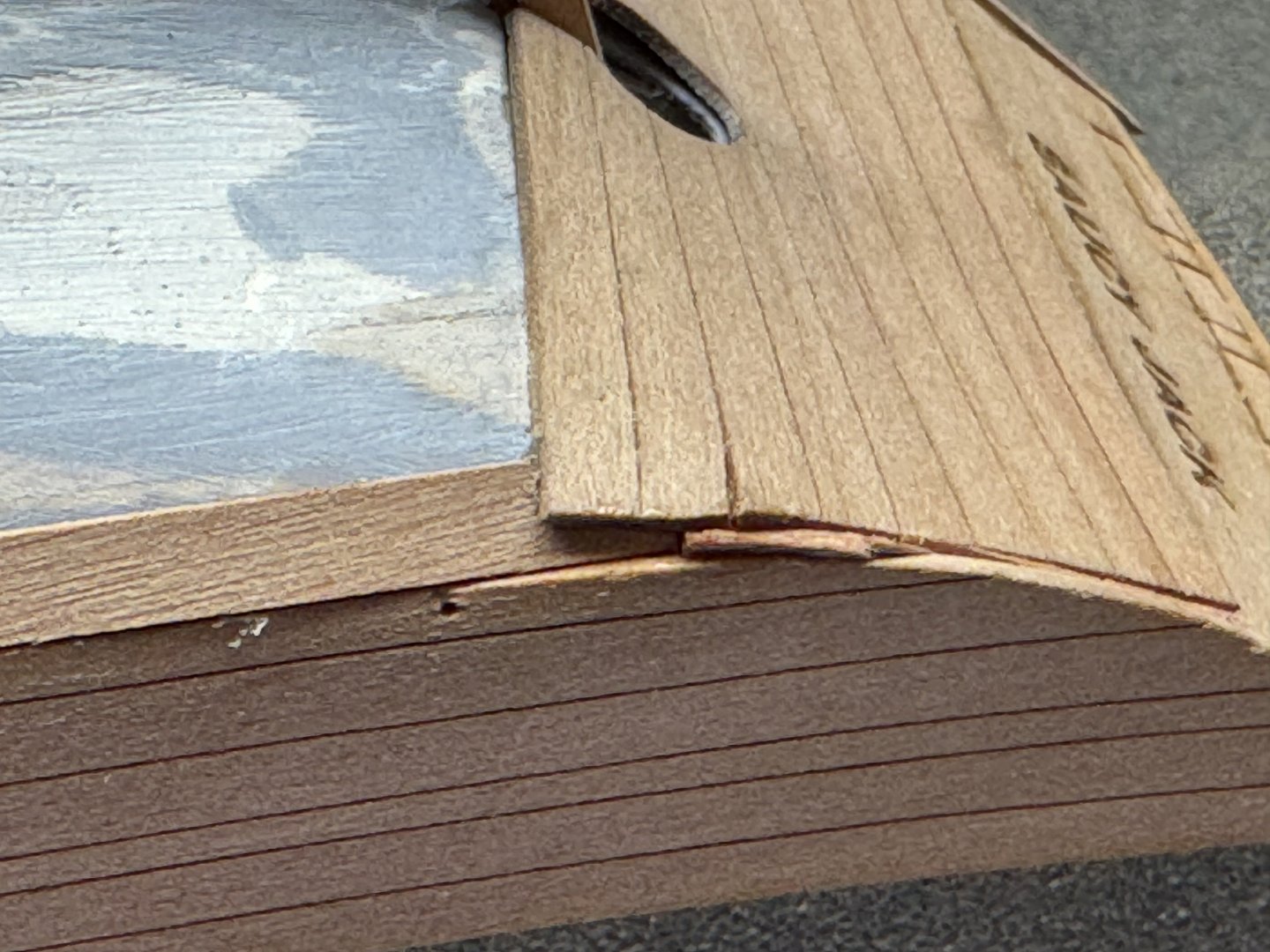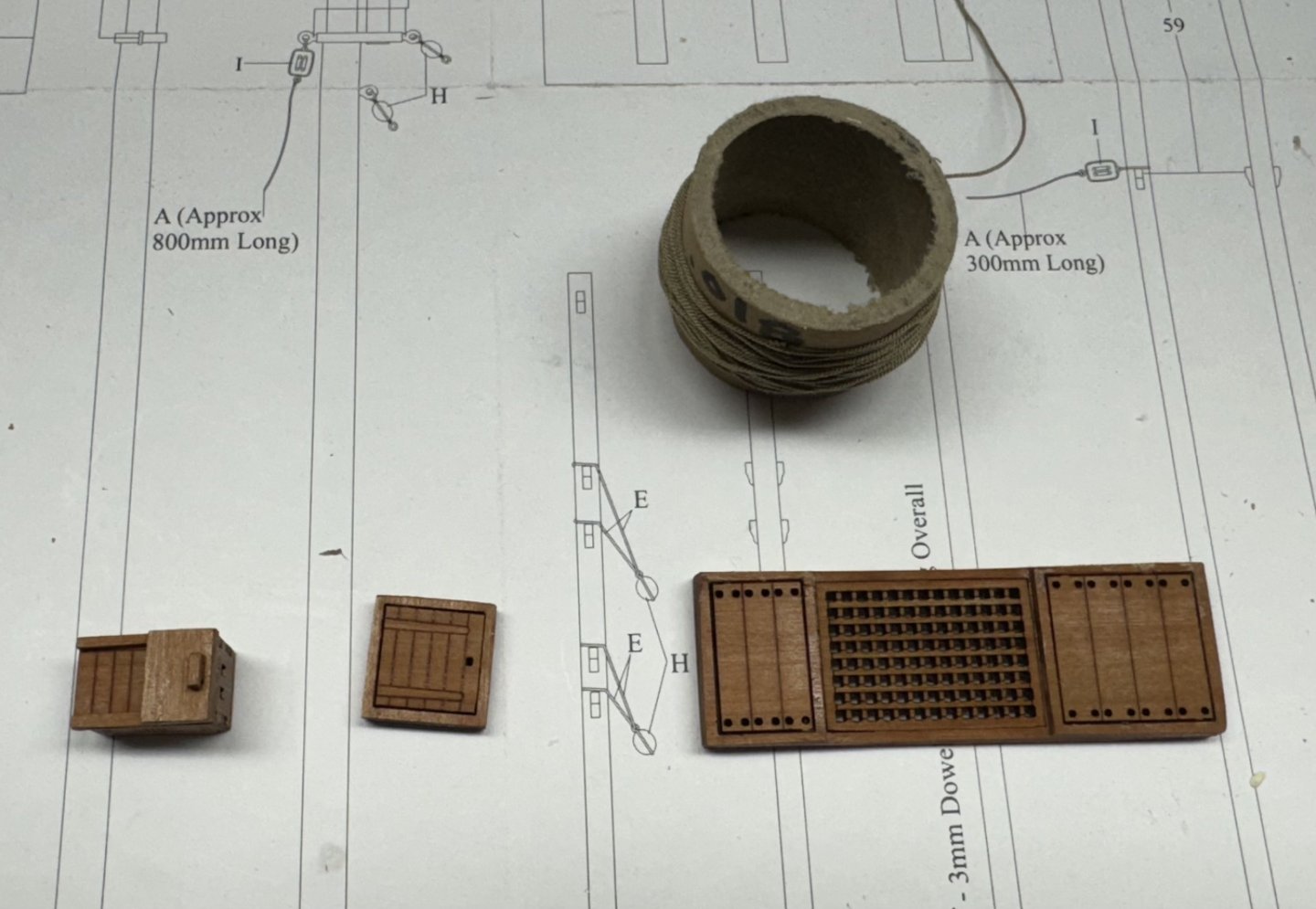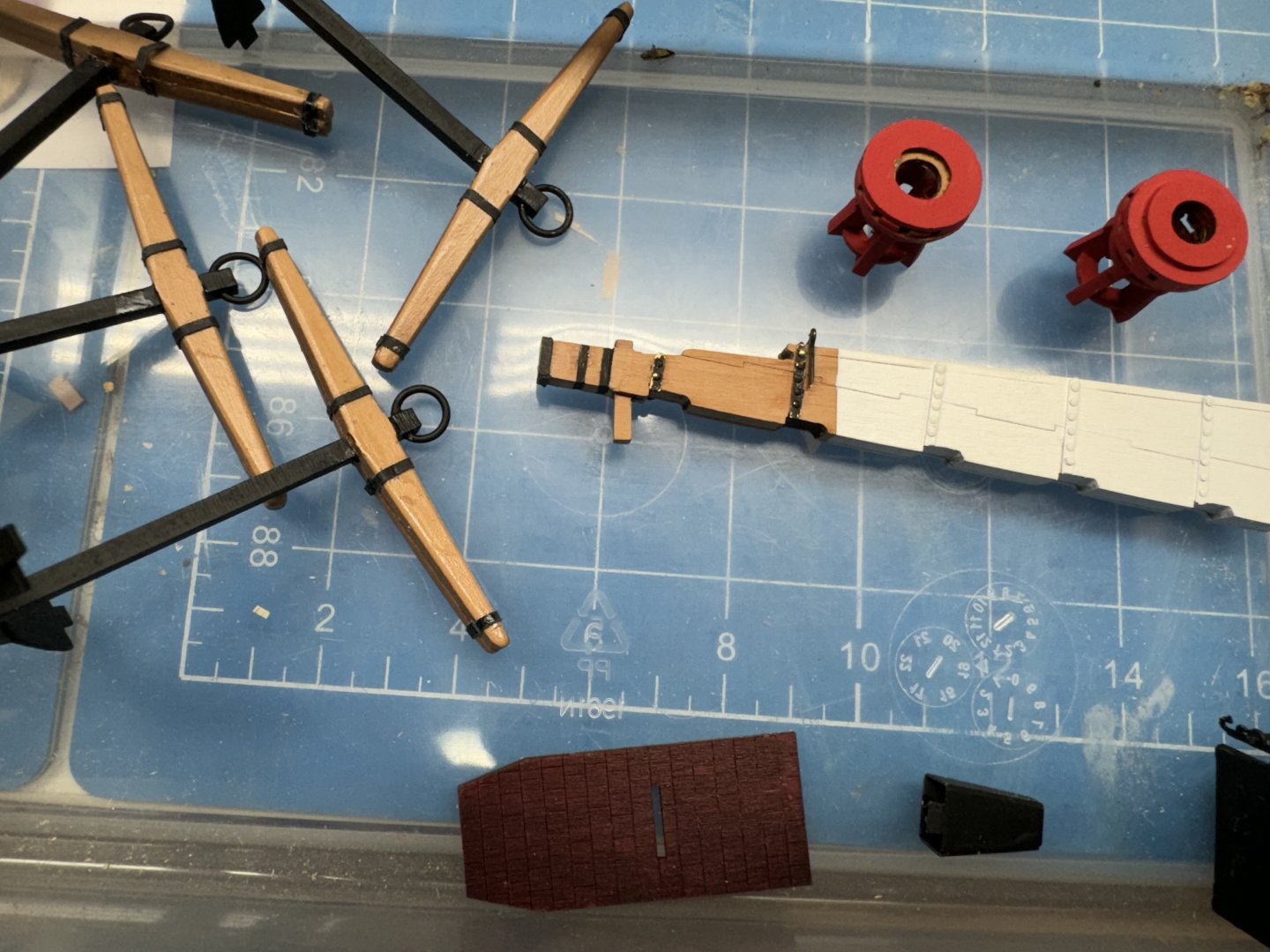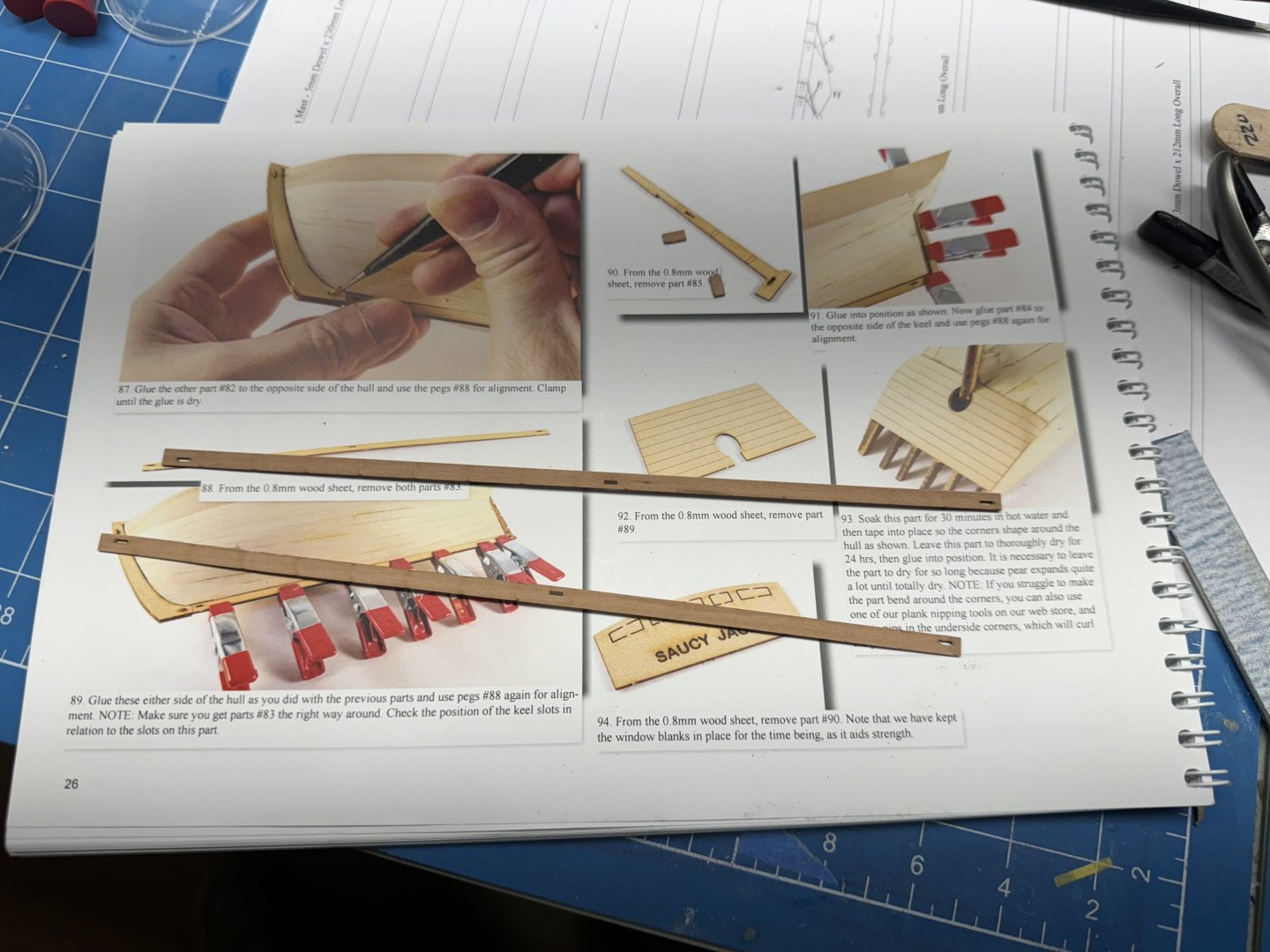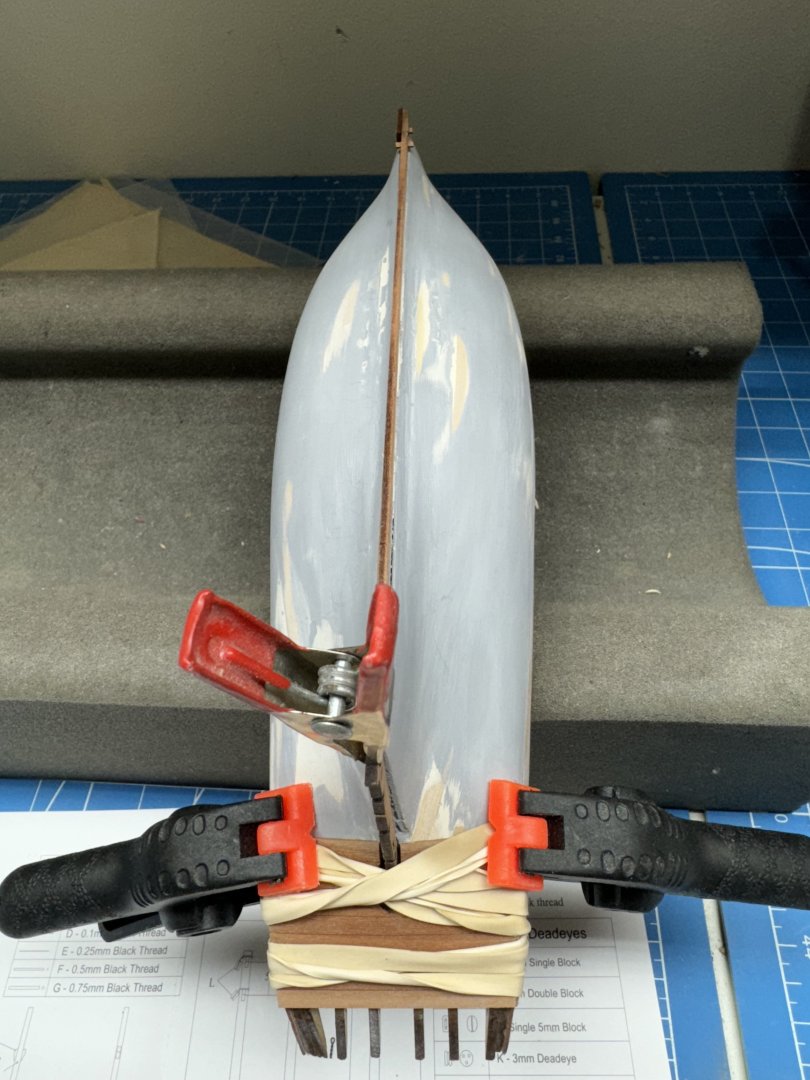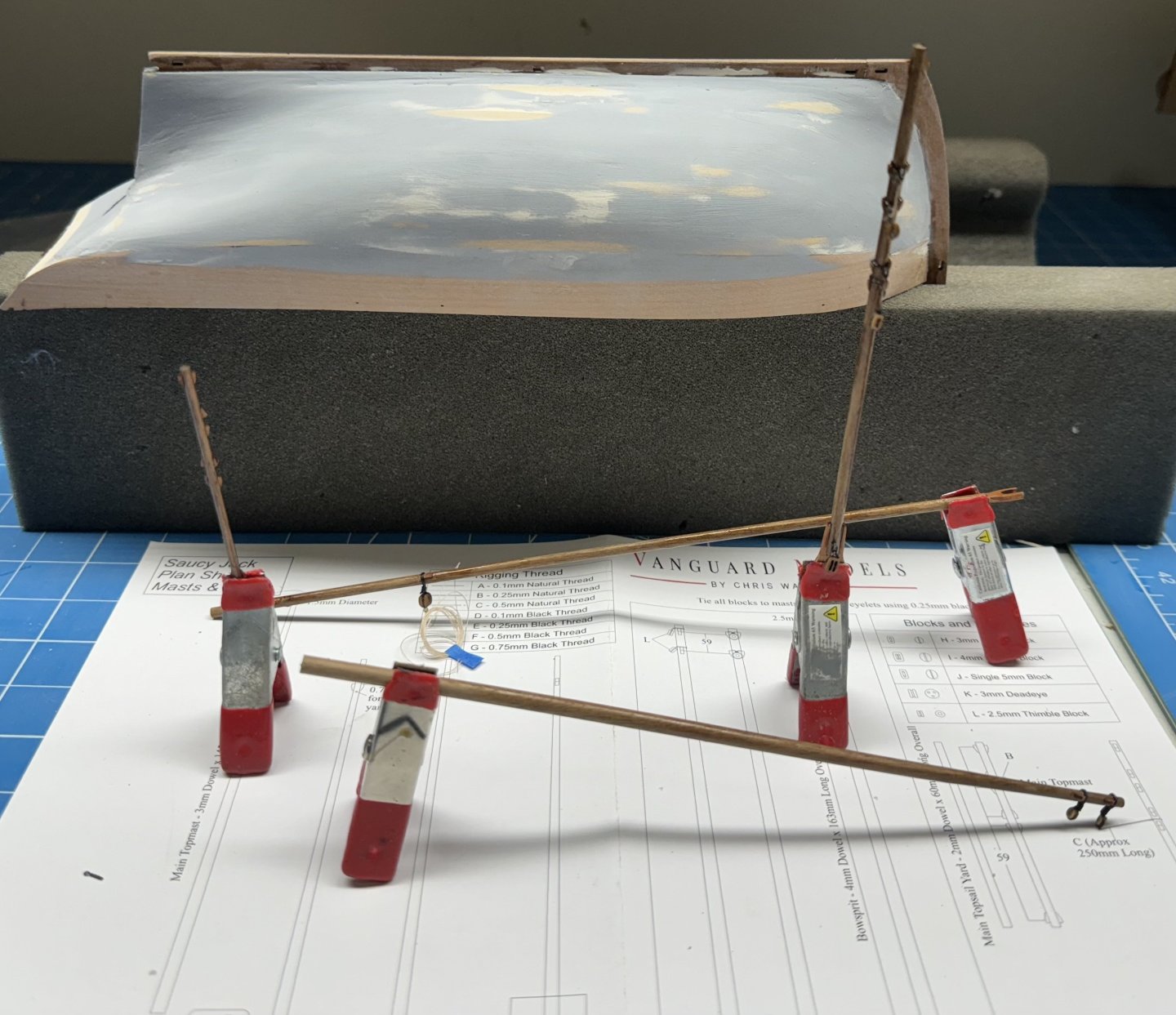-
Posts
1,915 -
Joined
-
Last visited
Content Type
Profiles
Forums
Gallery
Events
Everything posted by cdrusn89
-
Starboard side shrouds completed and deadeyes threaded with lanyards although not tied off yet. The port side has two shrouds completed and I will rig those and then tighten and tie off the lanyards one at a time alternating sides although given the dimensions of the mast and its secured well below deck the risk of distorting it is pretty small. I should also mention that in spite of the instructions to the contrary I have not glued in the bowsprit yet - along with the tiller it is too easy to get fouled by something. Both will go only when absolutely necessary. This is my first time using 100% polyester line for rigging lanyards and I am not sure I would use it again. When I get to the ratlines that will be the real test of the polyester. You have to be able to cut it cleanly with minimum "stress" and I am not sure how well it will perform. All this in preparation for HMS Sphinx which has three masts and many more deadeyes, lanyards and ratlines.
- 42 replies
-
- Saucy Jack
- Vanguard Models
-
(and 1 more)
Tagged with:
-
Now the "real" fun. Shrouds and deadeyes. My technique includes making the shrouds up (in pairs per the drawings) with one deadeye fixed in place and the other "adjustable" as well being able to control the overall length of the shroud my moving the adjustable deadeye. At the top of the lower mast the shroud pair goes over the top of the lower mast. The instructions would have the top mast in place at this point as well but I think it will just get in the way and plays no part in the lower shrouds so.... Anyway that is not really the area of interest. Down at the channels I used two pieces of .020 piano wire to make two (as identical as I could make them) "templates" for the deadeye spacing based on the drawing. Here you can see the two wire templates fitted into the center eye of the bottom deadeye and likewise into the upper deadeye. The left shroud length was fixed before installation so "all" that has to be done is to adjust the shroud length to hold the deadeye in place. If necessary (and it usually is) I use a piece of pencil eraser to hold the upper deadeye to the template. I have adjusted the right deadeye to tension the shroud and now a few drops of thin CA and it is on the port side for the next pair of shrouds.
- 42 replies
-
- Saucy Jack
- Vanguard Models
-
(and 1 more)
Tagged with:
-
You are welcome Horatio Nelson (I assume the h stands for Horatio). More pictures to follow.
- 42 replies
-
- Saucy Jack
- Vanguard Models
-
(and 1 more)
Tagged with:
-
Now with all the deck furniture added. I decided to leave the tiller off until the rigging is completed. It makes to tempting a target for an errant hand or tool. I purposely have the deadeyes tilted outboard to make threading the lanyards easier - but still not easy.
- 42 replies
-
- Saucy Jack
- Vanguard Models
-
(and 1 more)
Tagged with:
-
The hull is nearly complete. Just have to add the rudder and then start installing the deck furniture. FYI the blue tape is to protect the white hull from damage while it is being handled going forward. Don't ask me how I know the precaution is necessary. FYI - I used blackened brass belaying pins instead of the PE ones included. They are actually round like the real ones. As I mentioned previously I decided to paint the entire hull above the wales green.
- 42 replies
-
- Saucy Jack
- Vanguard Models
-
(and 1 more)
Tagged with:
-
Thanks Jacques! Here is the main sail mounted on the mast and gaff. I thought it came out alright. Only the flying jib (actually called the outer jib sail but my experience is that the most forward head sail is called the flying jib) left and it only has a block at the peak for the halyard tackle and sheet lines so I will leave that until I have the spars are in place and am really "hanging sails"..
- 42 replies
-
- Saucy Jack
- Vanguard Models
-
(and 1 more)
Tagged with:
-
I added some filler to the seam where the "new" piece was added. I will apply a coat of green then probably need another coat. While I had the green paint out I decided that the bare stripe I had above the wales was too thin and went ahead and painted the sides above the wales all green. I still have a strip of natural below the wales so there is some evidence that the hull was planked in the more or less conventional manner.
- 42 replies
-
- Saucy Jack
- Vanguard Models
-
(and 1 more)
Tagged with:
-
While waiting for the filler to dry on the transom I decided to continue the sail work on the main sail. The main is attached both to the mast with hoops and to the gaff with lashings. I decided to do the easier one first - hoops. I am using the Guttermann polyester thread as a substitute for that provided in the kit as I want to make sure I have enough to do this kit as well as Sphinx And I am terribly wasteful of rigging line. I think 600m will probably last me a lifetime. So the mast hoops are on the PE sheet which I previously cleaned (very important to clean the brass before painting - don't ask me how I know) and painted flat black. Using the drawing I determined that the hoops are 14-15mm apart and so I used a sharp awl to make a hole in the edge of the sail and threaded a piece of line through the hole. The through the hoop from the bottom with one side of the line and in from the top with the other. Then a simple overhand knot against the side of the hoop. Tighten the overhand knot while keeping the hoop to sail junction tight - it helps to have something handy to keep the sail from moveing. A very small drop of thin CA to seize the knot. When the CA sets, cut off the excess thread - I use cuticle clippers as they are quite sharp and easy to get into tight places.
- 42 replies
-
- Saucy Jack
- Vanguard Models
-
(and 1 more)
Tagged with:
-
Since very few people (thanks Jacques) seem to be looking at these posts I will have to be content with they will be here in case someone else actually builds the Saucy Jack. I am building it because it will fit in the designated (by she who must be obeyed) location. I probably would not have chosen it otherwise. So here is the jib on what will be the jib stay with all the appropriate lines/blocks attached. I also attached the top sail to the yard using the drawings as at least the starting point. On a less cheerful not I found that I did not adequately protect the stern of the vessel while handling it during the multiple iterations of sanding an filling. The upper portion, with the openings broke off - several times actually and finally I had to perform major surgery to remove the upper section of both the inner and out transoms. I decided that since I am unlikely to be able to get all the openings properly sized and spaced i would just fill in the area and call it done. I also decided to paint the interior transom area the same green as the stripe down the side. Although it does appear I made the stripe wider than instructions show and may decide to paint the hull all the way down to the wales green. So here is the stern repair waiting for the glue to dry and then some filler (maybe) and paint. The "B" means back as opposed to "F" for front so I did not glue it on backwards - the surgery was not completely bilaterally symmetric so the orientation matters.
- 42 replies
-
- Saucy Jack
- Vanguard Models
-
(and 1 more)
Tagged with:
-
While waaiting around for paint to dry and other "lulls" in activity I started to look at the sails. I purchased the "premium" sail set from Vanguard and they are a good deal more "finished" than the ones supplied with the kit. I started with the jib. Looking at the drawing (Sheet Plan 11) it is not easy (for me) to understand how the jib is attached to the jib stay except that it occurs at nine places (corners excepted) at the junctions between the several panels of material that make up the jib. I have sailed on a sailboat (mostly much smaller than the Saucy Jack) and the jib in those cases is attached to the fore stay with "hanks" which can be anything from spring loaded clips (on very small boats) to quite complex metal devices. For Saucy Jack I opted for the simplest (for me) implementation of a hank using 28 gauge annealed steel wire. I started by punching a hole in the jib at the edge using a sharp awl. Then I treaded a piece of 28 ga wire though the hole. Next I used the smooth end of a #40 drill bit and wrapped the wire around the bit with the two ends crossing on top on each other. I removed the drill bit and used a pair of lineman's pliers to squeeze the two wires together where they cross and cut the ends off close to the crossing point. I carefully put a drop of medium CA on the junction and held on for a minute or so for the CA to set. To "fly" the sail I will route the jib stay through the wire loops before terminating it at the bow and attaching the halyard and associated tackle. But there will be a bit in the future as I still have to figure out the other sails as well as finish the hull.
- 42 replies
-
- Saucy Jack
- Vanguard Models
-
(and 1 more)
Tagged with:
-
I remasked the waterline. It turned out about 1mm above where the filler ended most places. I will start the flat white in the morning. I painted the hull/tape junction with Tamiya XF-86 Flat Clear as I have heard that this helps to seal the junction and further reduces the prospect of the spray getting under the tape. I thought about using the Tru-Color flat clear I had left over from something else but I wanted a water based product so I ordered the Tamiya from Hobbylinc.
- 42 replies
-
- Saucy Jack
- Vanguard Models
-
(and 1 more)
Tagged with:
-
After three trips to the paint booth with filling and sanding in between I think I have the hull ready for the "final" waterline marking and then painting the below waterline portion flat white. Before doing the "real" waterline I carefully (I think) sanded down any ridge on paint/filler that developed while doing the fill/paint/sand routine. Here is the hull before I mark the waterline.
- 42 replies
-
- Saucy Jack
- Vanguard Models
-
(and 1 more)
Tagged with:
-
Pumps and gun deck hatch coamings and gratings ready for eventual installation. Will probably add another coat of WoP before (or maybe after) installation
- 422 replies
-
- Vanguard Models
- Sphinx
-
(and 1 more)
Tagged with:
-
The four ladders assembled and varnished. They are in their own "to be installed later" box and identified per the carrier sheets IDs. These were easier to assemble than some I have had occasion to build. I think principally because the slots for the steps are cut completely through the side. Others just burned an indented slot in the side and getting the steps to line up with and stick to that slot was not all that easy. These went together quickly and I use medium CA to glue in the steps as the outboard sides, with any glue mess is covered by the engraved ladder sides.
- 422 replies
-
- Vanguard Models
- Sphinx
-
(and 1 more)
Tagged with:
-
Proceeding apace I got the chain pumps assembled and varnished. I also built a Syren 1.25" ship's wheel from the mini-kit. It is a little larger (by about 3mm) then the brass one in the Sphinx kit. I will assemble the brass one later and decide which to use. Syren also makes a 15/16" wheel kit but I think that would be too small. Here are the pumps and the wheel. I think I may move on to the stairs next. I always seem to have a problem getting them together. Mine never seem to go together as "smoothly" as the instructions would indicate.
- 422 replies
-
- Vanguard Models
- Sphinx
-
(and 1 more)
Tagged with:
-
Both sides planked to the transition to stern post. I used full length planks until the last one since the fit is kinda critical at each end. Moving to garboard plank now then work up toward what is already done until that proves unworkable which may be sooner than I might hope.
- 42 replies
-
- Saucy Jack
- Vanguard Models
-
(and 1 more)
Tagged with:
-
At last - the outer bulwarks and first row of the second layer are done. I am using "medium CA" to glue the planks down - instructions say "gel" but my "thick CA" is really thick and says it is "gap-filling" which is not some thing that would be helpful if the CA fills a gap that needs to be occupied by a plank in the next row. The transition from the transom to the side planking did not go as well as I had hoped. I cut some small "filler" pieces and jammed them into the openings then had to modify the ends of the first row of planks to fit into the remaining opening. I am not sure how this is going to look after a bit of sanding but it will have to do as I am fresh out of ideas to make this area look better. At least it is somewhat consistent from side to side.
- 42 replies
-
- Saucy Jack
- Vanguard Models
-
(and 1 more)
Tagged with:
-
I am still fiddling around with the stern pieces. Can't seem to get everything to fit as they should. While slowly dealing with that I have been assembling the so called deck furniture. I have the fish hatch, companionway and forward hatch assembled and have applied (by brush) a coat of Wipe-on-Poly. I will add the rope to the hatches after the poly is dry. FYI - I am using Syren .018 Ultra Tan line for the hatch lines. In fact I am using Syren line in most everyplace I can. The smallest they make is .008" so I am using the provided (or similar) for the .1mm (.004") lines both dark and light. Here the hatches drying along with the line on my makeshift spool.
- 42 replies
-
- Saucy Jack
- Vanguard Models
-
(and 1 more)
Tagged with:
-
For those of you following the customs duty "saga" - UPS stopped a second time this PM and I now have both the Sphinx and Indy kits. Customs (or whatever) charge was $45.67 total for both kits. Pressing ahead with Saucy Jack until Monday anyway.
- 422 replies
-
- Vanguard Models
- Sphinx
-
(and 1 more)
Tagged with:
-
This is my first experience with customs duty on stuff from the UK. I bought HMS Speedy a few years ago and although I had to certify by signing some form that the MDF in the kit was "okay" in some sense there was no customs duty. Likewise with a number of purchases from the SipwrightShop but never anything like the value of a Sphinx kit. Interestingly I also have an Indy kit coming and the customs duty (or whatever the charge) is the same as for the Sphinx in spite it being almost double the cost. It is an ill wind - two more days to work on the Saucy Jack. might get the second layer of planking done by Monday.
- 422 replies
-
- Vanguard Models
- Sphinx
-
(and 1 more)
Tagged with:
-
New Sphinx kit has been delayed again - now $45.67 is customs duty is due "at delivery". I tried paying UPS on-line but that did not work for some reason so they will attempt delivery again on Monday - I will be sure to stay home Monday! Anyway I have been working Saucy Jack and some of the other pieces of the Sphinx. Here are the upper and lower capstans and the rudder (as far as I can go I think without the hull) joining the other pieces in the "to be installed someday" box.
- 422 replies
-
- Vanguard Models
- Sphinx
-
(and 1 more)
Tagged with:
-
When I went to add the outer "patterns" to the keel I noticed that in addition to the slots not being equidistant from the ends they are also not equidistant from the top (or bottom). Don't ask me how I know but it IS possible to get them on "upside down". I believe the correct orientation is with the larger portion toward the bottom of the keel. It IS possible to get at least one on the other way but the difficulty getting the second one on caused my to re-examine things and come to the above realization. I moved on to the lower counter outer "pattern". Having learned that it is entirely possible for the part to slip while adding the rubber bands I decided to form the part first and then glue it down. As I have seen before, when completely dry the pear wood will retain the shape assumed when wet. Once that is done I will go back and add the outer keel (and stern post) patterns and get on with the second layer of planking.
- 42 replies
-
- Saucy Jack
- Vanguard Models
-
(and 1 more)
Tagged with:
-
New Sphinx kit has been delayed - now due Friday. Will concentrate on Saucy Jack and trying to bring some order out of the disorder before starting the new hull.
- 422 replies
-
- Vanguard Models
- Sphinx
-
(and 1 more)
Tagged with:
-
Thanks Rick! Anyway i got the rest of the spars completed and have the appropriate blocks and such attached as per the instructions. The bowsprit and boom still have some extra length that makes for a handy place to grab them while applying the Wipe-on-Poly. For the spars I did that with a small disposable "brush" as trying to use a cloth is very hard around all the "stops" that seem to be attached at every opportunity. I also have the hull in good enough shape to proceed. to my dismay I find that the primer plus filler that I previously bought at an auto parts store is no longer carried. IO tried some Rust-oleum Primer plus filler from Walmart but I either bought the wrong one or this is a very different product from what I used before as the filler clogs up the sand paper in very short order - which did not happen with whatever ir was I used previously - of course I do not have a can lying around. So now to trim up the over long spars and start preps for hull planking layer 2.
- 42 replies
-
- Saucy Jack
- Vanguard Models
-
(and 1 more)
Tagged with:
-
The rudder ready for the paint booth. I will take a chance that I can use this rudder to set the waterline on the new hull. Otherwise I would have to leave the rudder "as is" and wait until I have the hull waterline established which is probably several months in the future. And I can always build another rudder although I would not be looking forward to cutting the heads of another six dozen brass pins. I believe the new Sphinx kit will be here Thursday. I am still trying to figure out the best way to proceed without becoming hopelessly confused about which part is where. That is a big enough problem with just one box (and a large box it is) to content with.
- 422 replies
-
- Vanguard Models
- Sphinx
-
(and 1 more)
Tagged with:
About us
Modelshipworld - Advancing Ship Modeling through Research
SSL Secured
Your security is important for us so this Website is SSL-Secured
NRG Mailing Address
Nautical Research Guild
237 South Lincoln Street
Westmont IL, 60559-1917
Model Ship World ® and the MSW logo are Registered Trademarks, and belong to the Nautical Research Guild (United States Patent and Trademark Office: No. 6,929,264 & No. 6,929,274, registered Dec. 20, 2022)
Helpful Links
About the NRG
If you enjoy building ship models that are historically accurate as well as beautiful, then The Nautical Research Guild (NRG) is just right for you.
The Guild is a non-profit educational organization whose mission is to “Advance Ship Modeling Through Research”. We provide support to our members in their efforts to raise the quality of their model ships.
The Nautical Research Guild has published our world-renowned quarterly magazine, The Nautical Research Journal, since 1955. The pages of the Journal are full of articles by accomplished ship modelers who show you how they create those exquisite details on their models, and by maritime historians who show you the correct details to build. The Journal is available in both print and digital editions. Go to the NRG web site (www.thenrg.org) to download a complimentary digital copy of the Journal. The NRG also publishes plan sets, books and compilations of back issues of the Journal and the former Ships in Scale and Model Ship Builder magazines.



